Every parent, caregiver, or homeowner with children in their lives knows the familiar sight: toys. They multiply overnight, spill from bins, and often find their way into every corner of your home. You desire a peaceful, functional space, but the sheer volume of playthings often overwhelms your efforts. Many struggle to find effective toy organization solutions that actually stick, leading to endless tidying cycles and constant frustration.
This article delivers practical, actionable strategies for taming the toy chaos and creating systems that work for the long haul. We understand your time is precious, your budget might be tight, and your space often feels limited. This guide addresses those real-life challenges, offering realistic advice for busy homeowners, renters, and apartment dwellers. You will discover how to implement functional systems that bring order to your home, reduce stress, and empower your children to engage with their toys more meaningfully.

Understanding the Toy Tsunami: Why Organization Matters
Before diving into specific solutions, consider the impact of toy clutter on your daily life and your child’s development. Unorganized toys create visual clutter, contribute to stress, and make finding specific items difficult. This leads to children dumping out entire bins to find one toy, which then creates an even bigger mess. For you, this means more time spent tidying and less time enjoying your home or engaging with your children.
Benefits of effective toy organization:
- Reduced Stress: A tidy environment calms the mind, reducing parental overwhelm and making your home feel more peaceful.
- Increased Play Value: When toys are visible and accessible, children play with them more. They discover new ways to engage with their existing collection rather than constantly asking for new items.
- Life Skills Development: Implementing kids room organization teaches children responsibility, decision-making, and categorization skills from a young age.
- Improved Safety: Fewer tripping hazards mean a safer play environment for everyone.
- Easier Maintenance: A well-designed system makes daily tidying quicker and less daunting. You spend minutes, not hours, putting things away.
Imagine walking into a child’s room where everything has a place, and your child can easily retrieve and return their toys. This vision is entirely achievable with the right strategy and consistent effort.
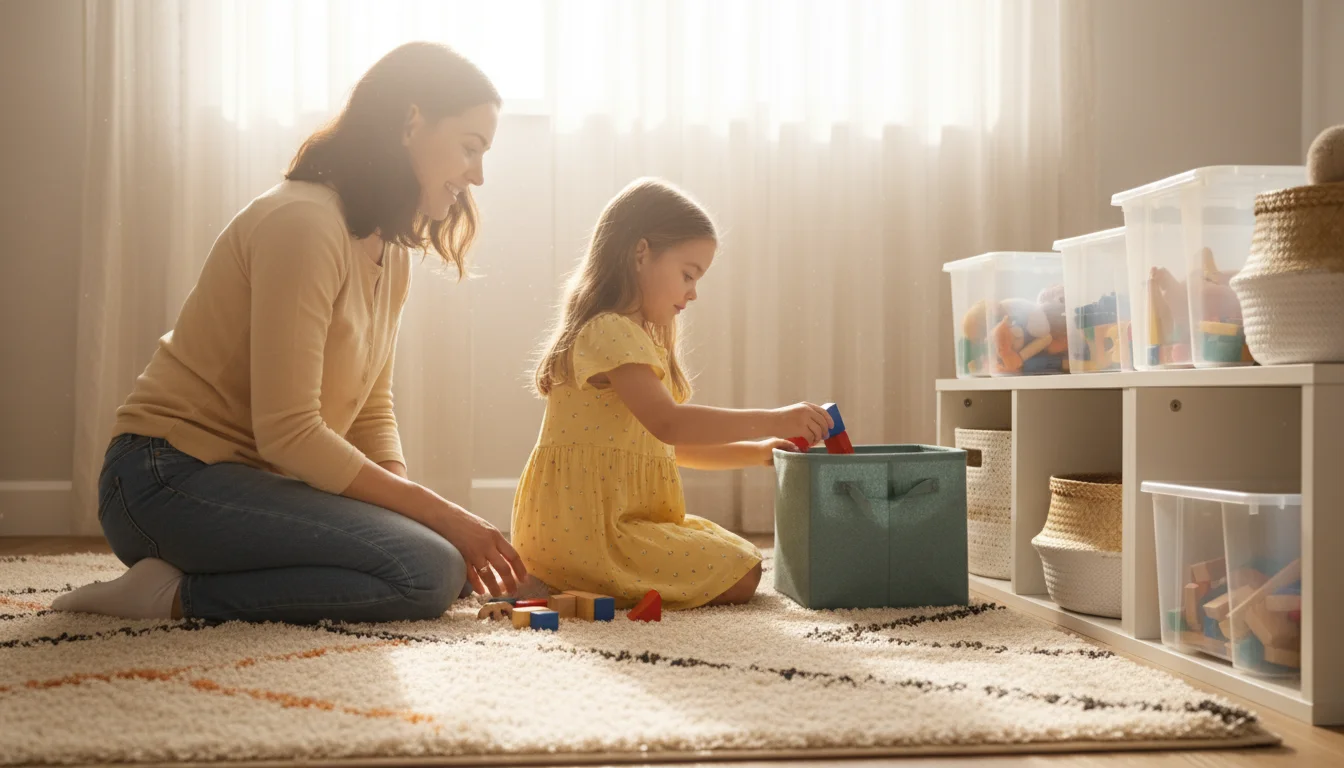
The BrightLivingGuide.com Philosophy: Realistic Toy Organization
Many organization guides promise perfection, but we know real life involves sticky fingers, evolving interests, and busy schedules. Our approach focuses on creating “good enough” systems that you can actually maintain. Perfection is the enemy of progress, especially when it comes to toy organization. You need a system that adapts as your children grow and their interests shift.
Key principles of realistic toy organization:
- Start Small: Do not try to organize every toy in your home in one day. Focus on one area, or even one category of toys, to build momentum.
- Involve Your Children: Age-appropriately, involve your children in the decluttering and organizing process. This fosters ownership and makes them more likely to maintain the system. Even toddlers can help put blocks in a designated bin.
- Function Over Aesthetics: While a beautiful system is nice, a functional system is essential. Prioritize ease of use for both you and your children.
- Be Flexible: What works for a preschooler’s toys will not work for a teenager’s collectibles. Your system needs periodic review and adjustment.
- Embrace Imperfection: Your home will not always be perfectly tidy. The goal is a system that allows for quick resets and prevents overwhelming clutter.

Phase One: Decluttering the Toy Chaos
Before you organize, you must declutter. Attempting to organize too many items is a recipe for failure. This step is crucial for establishing effective toy storage solutions that stand the test of time.
Step-by-step decluttering process:
- Gather Everything: Collect all toys from a designated area (e.g., the child’s bedroom, the living room play zone). Dump them into one central spot. This visual representation of the volume helps you grasp the task.
- Sort into Categories: Create distinct piles or bins for similar items. Examples include:
- Blocks and building toys
- Dolls and accessories
- Art supplies
- Board games and puzzles (ensure all pieces are present)
- Action figures and small characters
- Vehicles
- Plush animals
- Outdoor toys
- Books
This categorization helps you see what you have in abundance and identify duplicates.
- Make Decisions (The “Keep, Donate, Trash” Method): For each toy, ask yourself:
- Keep: Is it loved, played with regularly, age-appropriate, and in good condition? Does it hold sentimental value or support developmental goals?
- Donate/Sell: Is it gently used, complete, and something another child could enjoy? Consider local charities, consignment shops, or online marketplaces.
- Trash/Recycle: Is it broken, missing critical pieces, unsafe, or beyond repair? Be ruthless with these items.
Involve your child in this process, especially for items in the “Donate” pile. Empower them to make choices about which toys they are ready to pass on to other children who might need them more. However, maintain parental oversight to ensure practical decisions.
- The “Maybe” Box (Optional but Recommended): If you and your child struggle with letting go of certain items, place them in a “maybe” box. Label it with a date (e.g., “Review in 3 months”). Store this box out of sight. If your child does not ask for or remember these toys by the review date, you can confidently donate them without revisiting the decision. This strategy often eases the emotional burden of decluttering.
- Designate an “Out of Rotation” Area: For younger children, rotating toys keeps play fresh and prevents overwhelm. Designate a closet shelf or a lidded bin for toys that can go “on vacation.” Introduce new toys from this stash every few weeks, and put current favorites into rotation. This reduces the number of toys out at any given time.
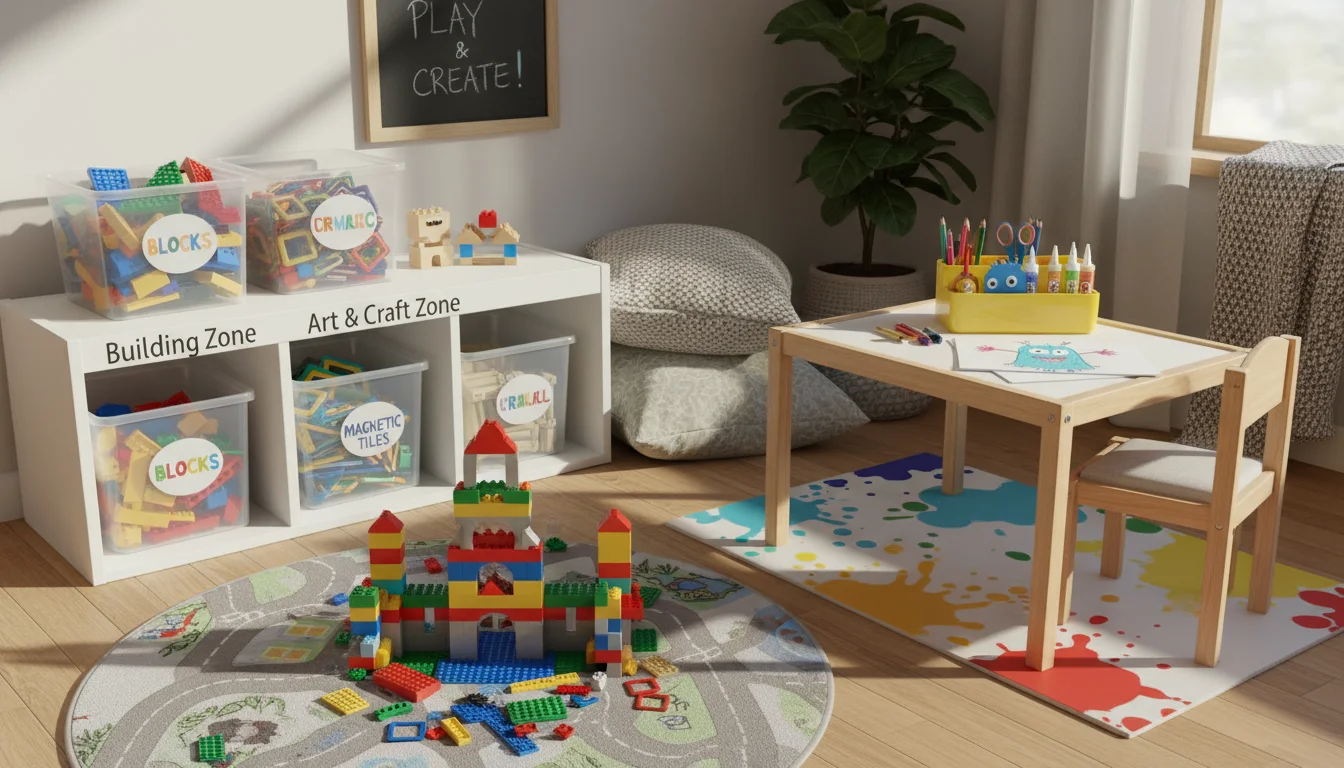
Phase Two: Designing Effective Toy Zones
After decluttering, you have a clearer picture of your toy collection. Now, design zones for these toys. “Zones” are designated areas for specific types of activities or items. This strategy provides structure and predictability for both you and your child.
How to create toy zones:
- Identify Play Areas: Consider where your child naturally plays. Is it primarily in their bedroom? A corner of the living room? A dedicated playroom? Design zones based on these actual usage patterns.
- Categorize by Activity or Type: Group similar toys together. For example:
- Building Zone: Blocks, LEGOs, magnetic tiles. Keep these together for easy access during construction play.
- Art & Craft Zone: Crayons, paper, markers, craft supplies. Often best near a table or desk.
- Reading Nook: Books, cozy cushions, soft toys. A quiet corner encourages independent reading.
- Imagination Play: Dolls, dress-up clothes, play kitchen items.
- Active Play: Balls, ride-on toys, large motor skill items. Often suited for a larger, open area.
- Map Out Your Space: Physically or mentally divide your room into these zones. Place storage containers within the relevant zone. For example, store art supplies near the art table, and books near the reading chair.
- Consider Accessibility: Ensure young children can easily access and put away their toys independently. This means low shelves, open bins, and clearly labeled containers.
- Think Vertically: Maximize vertical space with bookshelves, wall-mounted shelving, or cubby organizers, especially in smaller rooms. This keeps floors clear for play.
Creating these zones helps you visualize where everything belongs, simplifying the put-away process. It also helps children understand where to find what they need, fostering independent play and tidying habits.
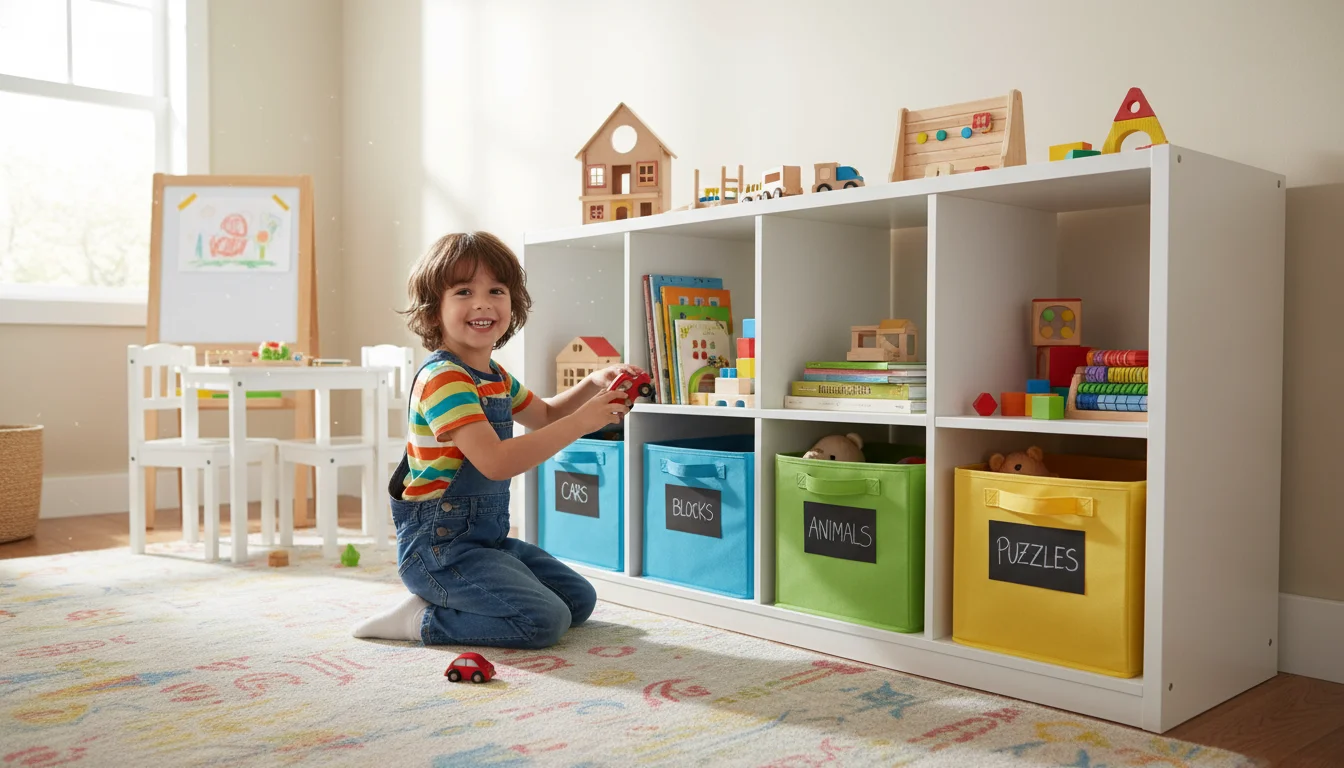
Product Deep Dive: Top Toy Storage Solutions That Last
Once you have decluttered and identified your zones, selecting the right toy storage solutions becomes much easier. The market offers a vast array of products, but focusing on durability, functionality, and ease of use ensures your investment pays off long-term.

Modular Cube Organizers (e.g., IKEA Kallax or similar brands)
These highly versatile units offer open shelving, which is excellent for accessibility. You can customize them with fabric bins, baskets, or doors to hide clutter or categorize items. They often come in various sizes, fitting diverse spaces.
- Pros: Extremely versatile, durable, aesthetically pleasing, easy for children to access, good for categorizing. You can find options like the IKEA Kallax system.
- Cons: Can be bulky in very small rooms, requires purchasing additional bins/baskets.
- Best for: Grouping larger toys, board games, books, or smaller themed bins. Excellent for building “zones” within a room.
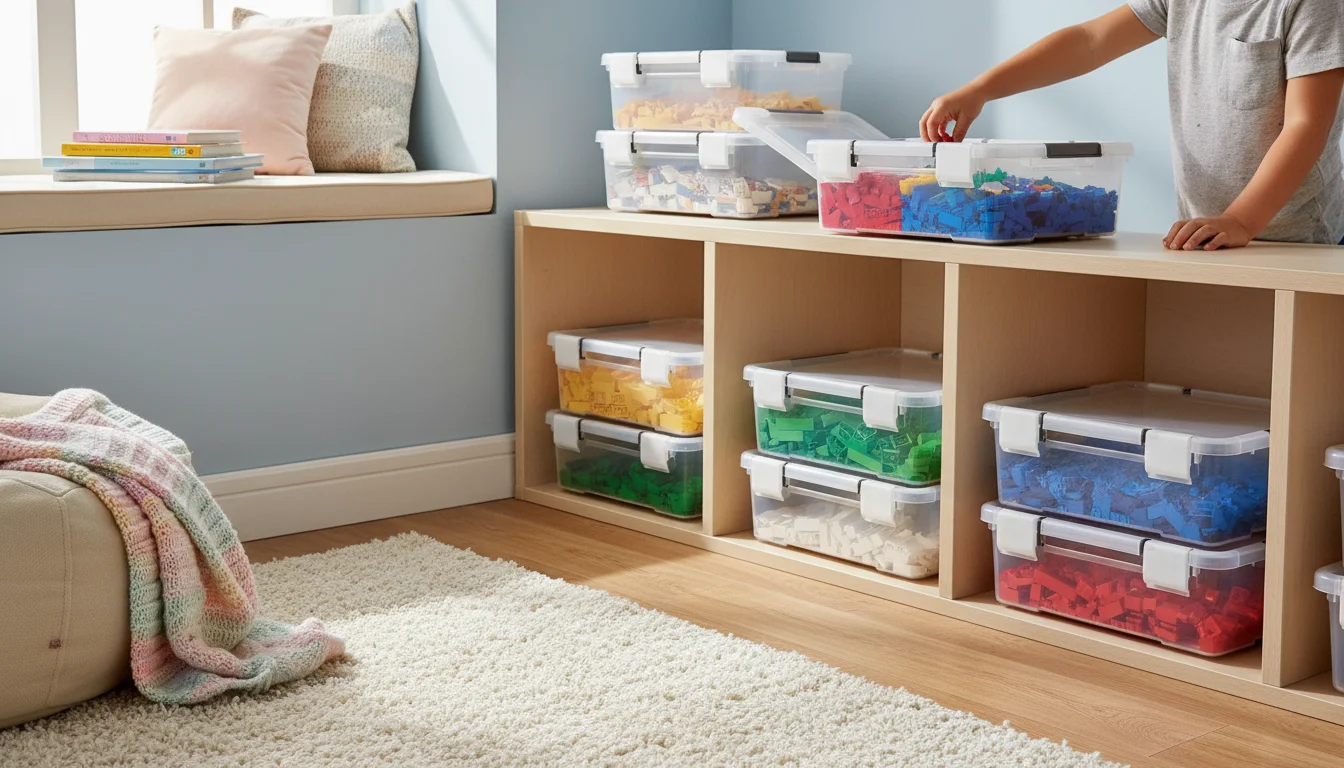
Clear Plastic Bins with Lids
Clear bins allow you to see contents at a glance, eliminating the need to rummage. Lids provide stackability, maximizing vertical storage in closets or under beds. Choose durable, BPA-free plastic for longevity.
- Pros: Contents are visible, stackable, protect toys from dust, budget-friendly, easy to clean.
- Cons: Can look cluttered if not carefully organized, lids might be difficult for very young children to open/close independently.
- Best for: LEGOs (sorted by color or type), craft supplies, small collections (e.g., action figures, doll accessories), seasonal toy rotation.
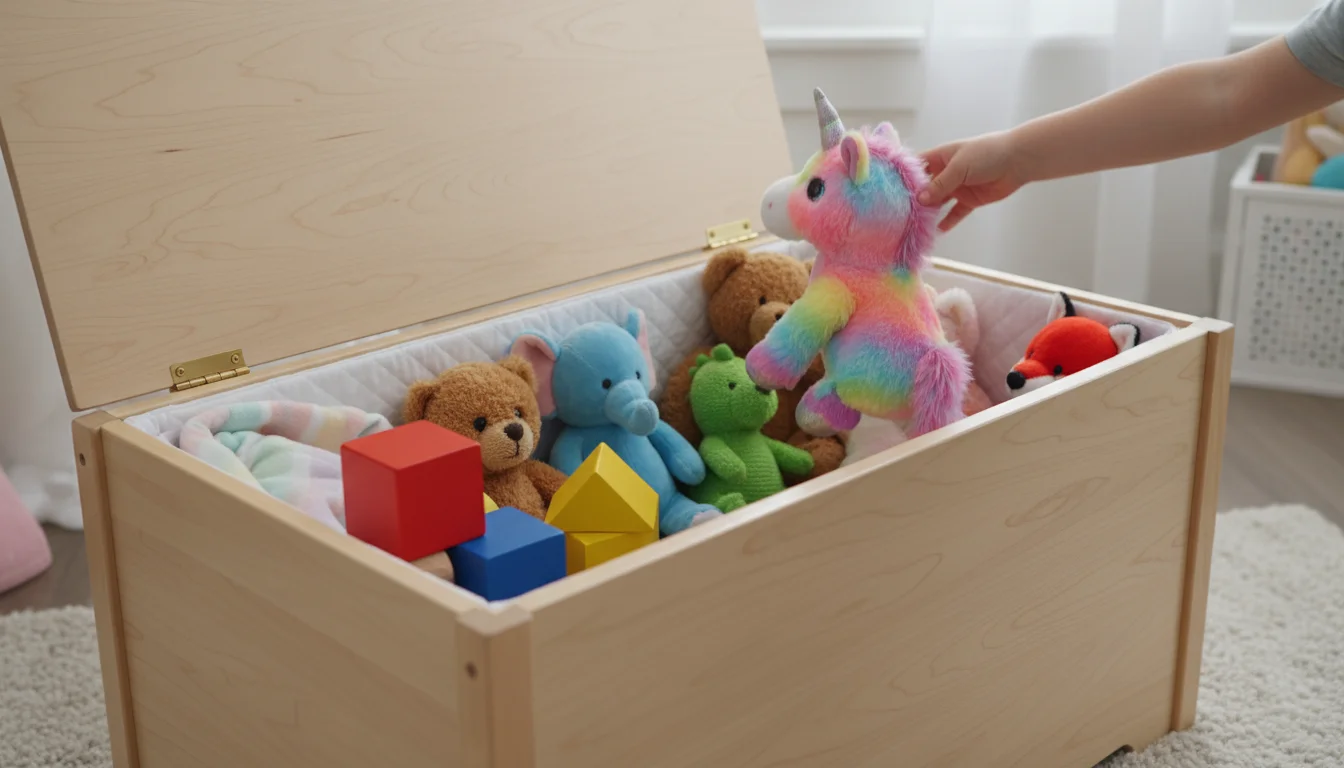
Toy Bins/Chests with Soft Closures
Traditional toy chests offer ample storage, but look for models with safety hinges that prevent lids from slamming shut on little fingers. Large, open bins are also excellent for quick tidying.
- Pros: Large capacity, quick clean-up for bulky items, can double as seating (with a cushion).
- Cons: Toys at the bottom are hard to find, can become a “dumping ground” if not managed.
- Best for: Plush animals, oversized vehicles, dress-up clothes, blankets, or mixed collections where specific items do not need to be easily visible.
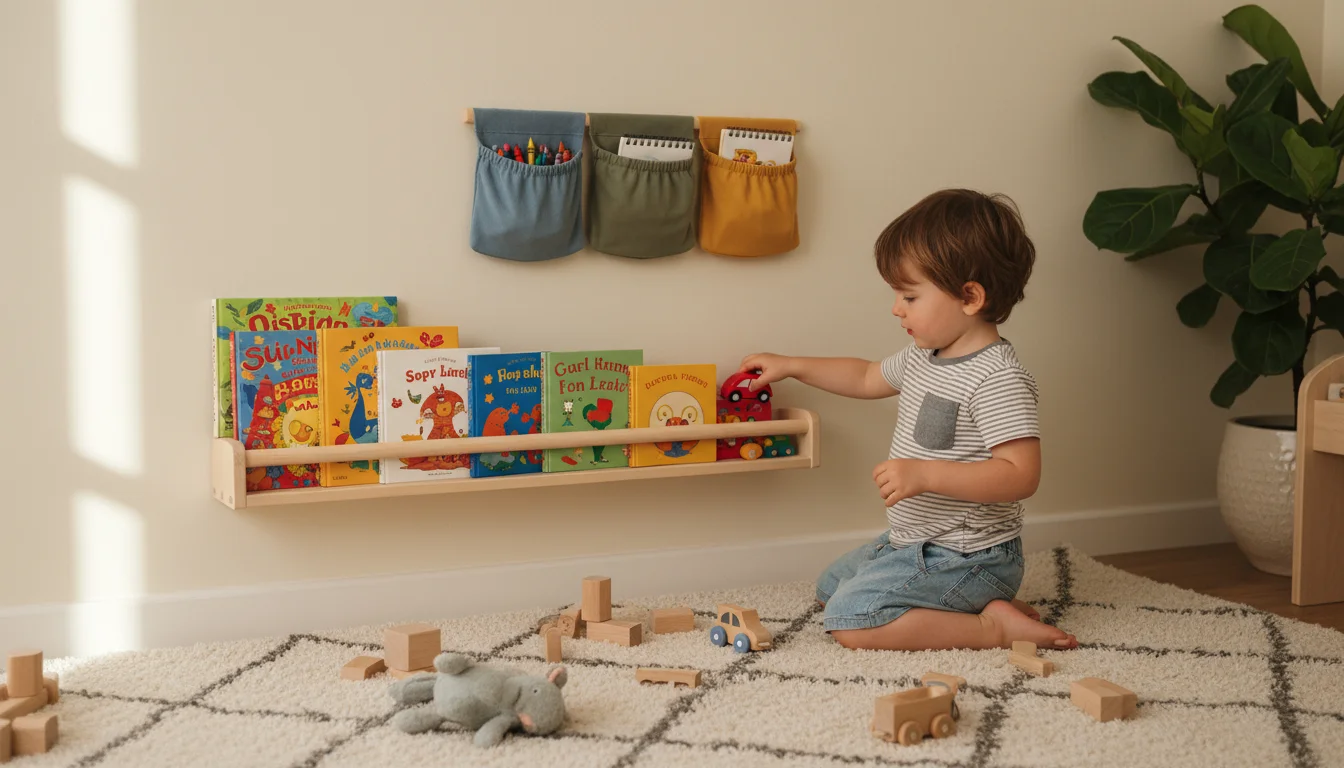
Wall-Mounted Shelves and Pockets
When floor space is limited, look to your walls. Floating shelves, picture ledges, or fabric wall pockets store books, small collectibles, or art supplies without taking up valuable real estate.
- Pros: Saves floor space, great for displaying beloved items, keeps certain items out of reach of toddlers.
- Cons: Requires installation, may not hold heavy items, children cannot access independently if mounted high.
- Best for: Books, small LEGO creations, trophies, display items, art supplies.
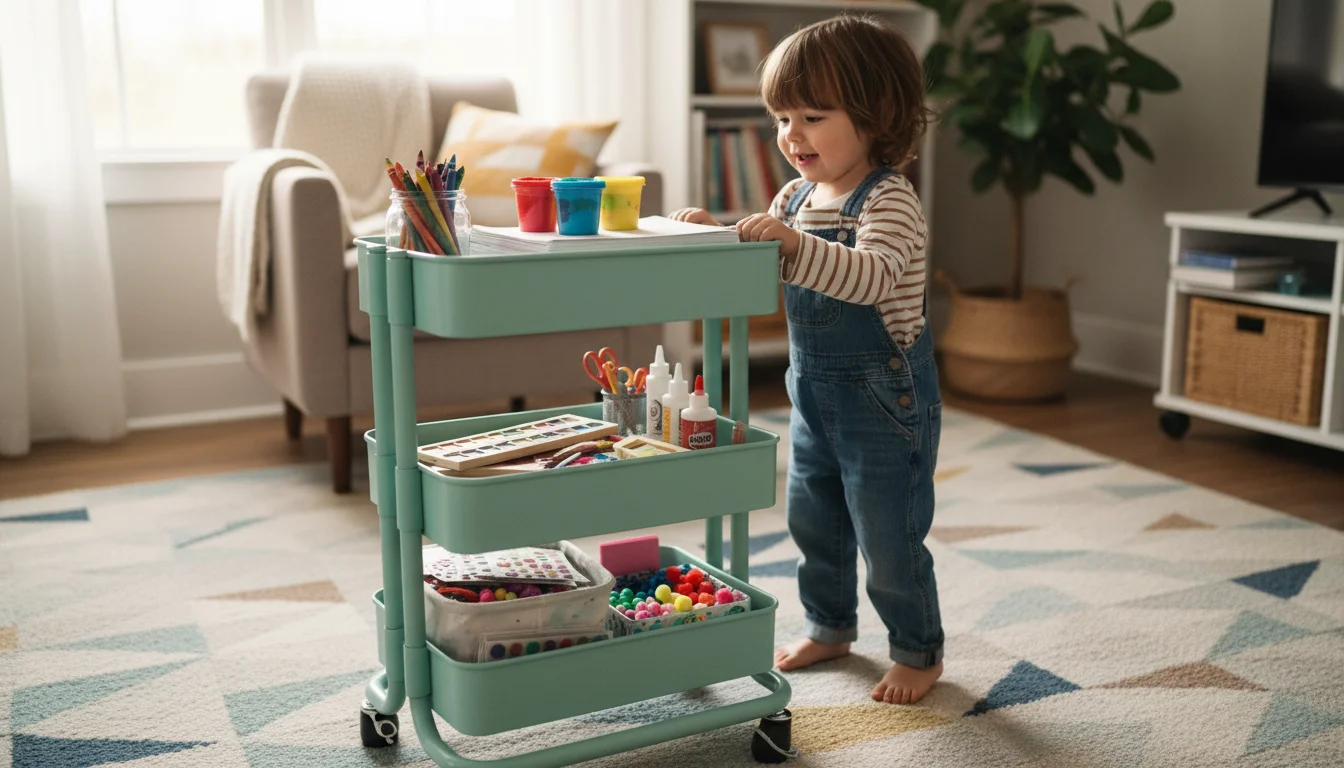
Rolling Carts (e.g., utility carts)
Multi-tiered rolling carts offer portable storage for craft supplies, small building toys, or items used across multiple areas of the home. You can wheel them into a play zone and then tuck them away when not in use.
- Pros: Portable, visible storage, often slim, durable.
- Cons: Can be visually busy if not neatly organized, may tip if overloaded or if a child climbs on it.
- Best for: Art supplies, current projects, small toys that move between rooms, homeschooling supplies.
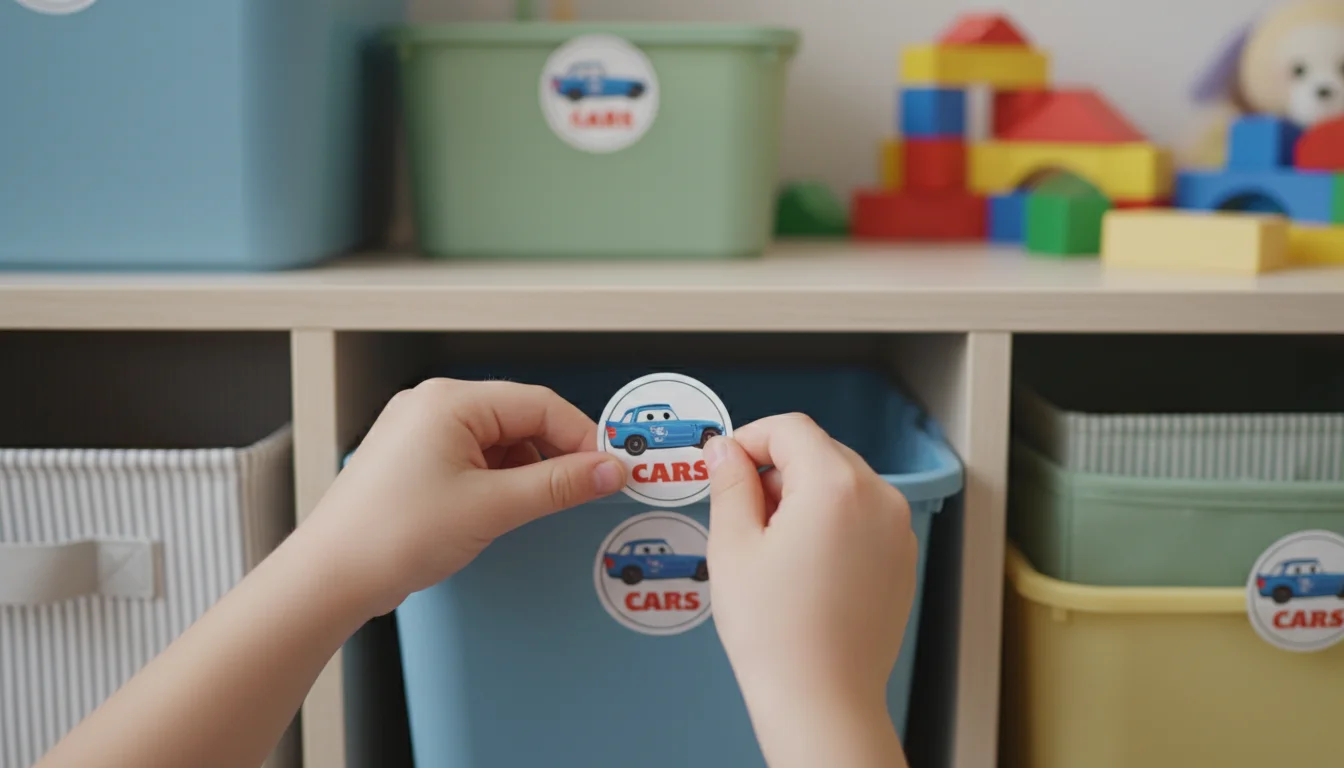
Labeling Systems
Regardless of the storage solution you choose, labels are your best friend. Use picture labels for pre-readers and word labels for older children. Consistent labeling ensures everyone knows where items belong, facilitating independent clean-up.
- Pros: Crucial for maintaining the system, empowers children, reduces confusion.
- Cons: Requires initial effort to create and apply.
- Best for: All storage containers, especially opaque bins.
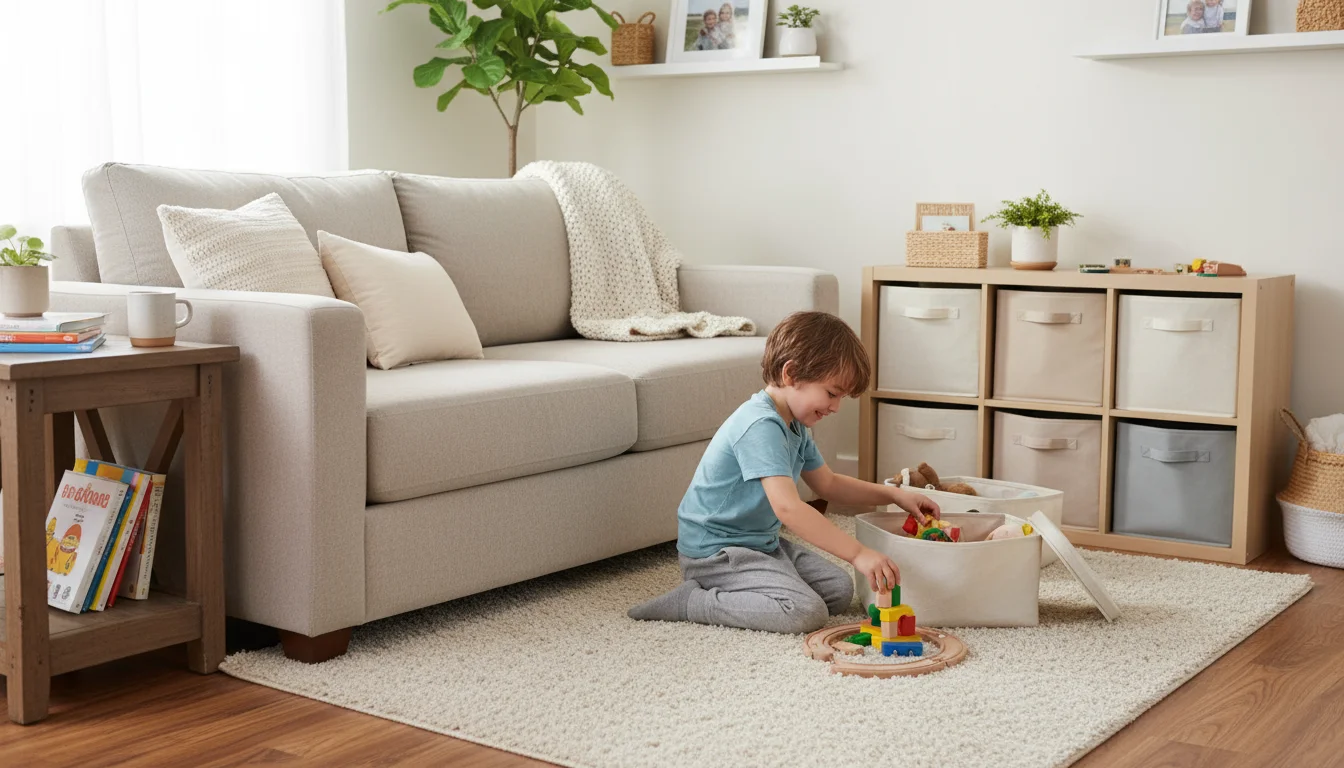
Tailoring Solutions for Different Spaces
Your home’s layout dictates the best approach to kids room organization. Here are strategies for common scenarios:
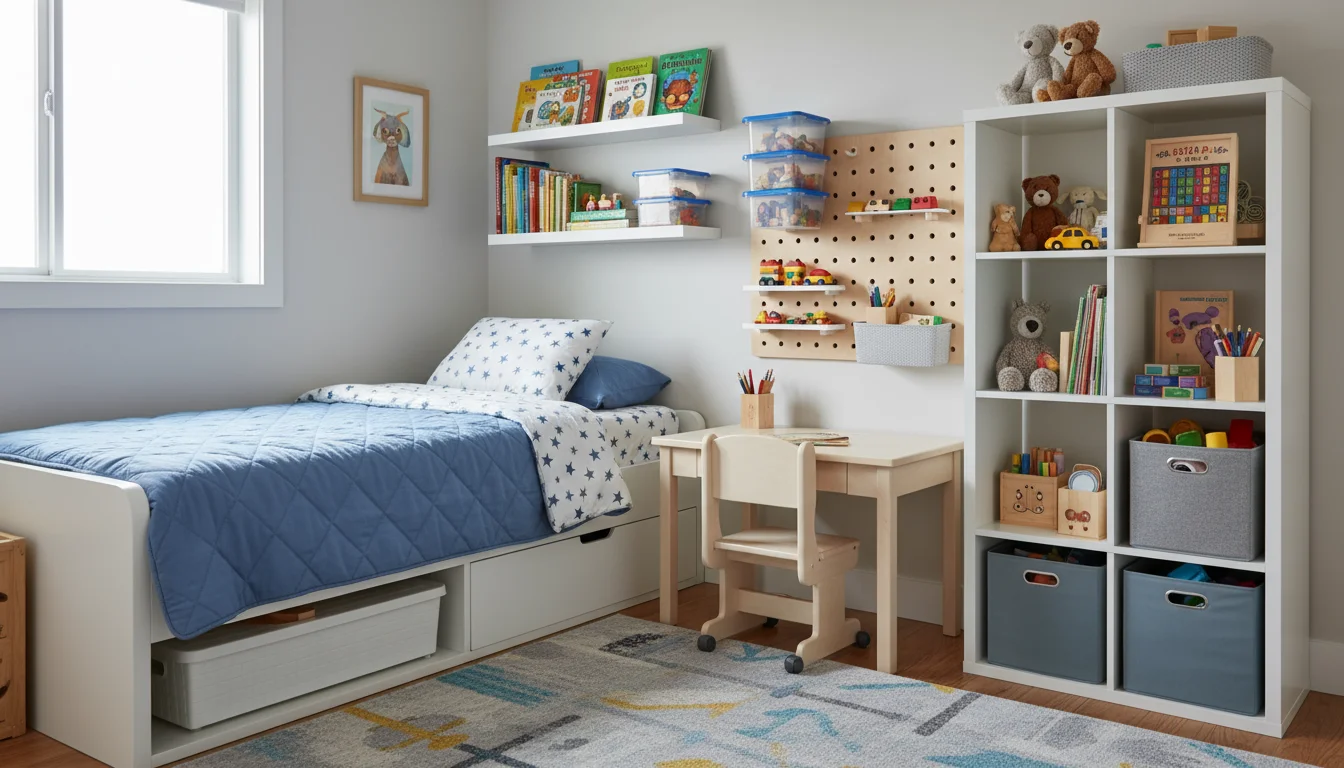
Small Bedrooms or Apartments
Maximize every inch when space is at a premium. Think vertically and use multi-functional furniture.
- Under-Bed Storage: Slim, lidded bins on wheels slide neatly out of sight.
- Wall-Mounted Solutions: Shelves, pegboards, and fabric pockets free up floor space.
- Vertical Organizers: Cube units, tall bookcases, or over-the-door shoe organizers repurposed for small toys.
- Multi-Functional Furniture: Ottomans with storage, bench seats with lift-top lids, or beds with built-in drawers.
- Toy Rotation: Keep only a select number of toys out, storing the rest in a closet or under the bed, rotating them periodically. This prevents small spaces from feeling overwhelmed.
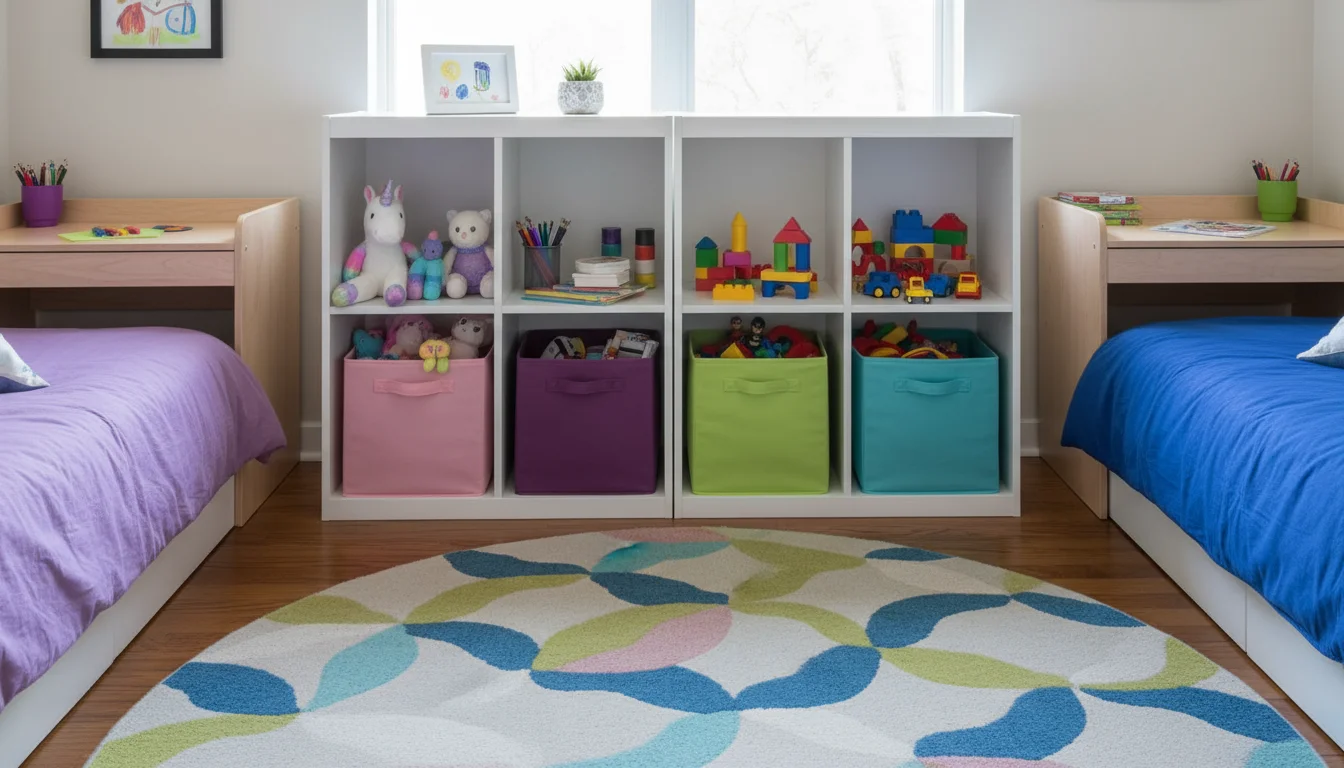
Shared Bedrooms
When siblings share a room, clear boundaries and individual storage become essential to prevent squabbles and maintain order.
- Personal Zones: Designate specific sides of the room or sets of shelves for each child’s personal belongings and cherished toys.
- Shared Zones: Create clearly defined areas for communal toys (e.g., building blocks, board games).
- Color-Coding: Assign each child a color, and use bins or labels in their color for their personal items.
- Vertical Dividers: Use tall bookshelves or cube organizers as room dividers to create a sense of individual space within a shared room.
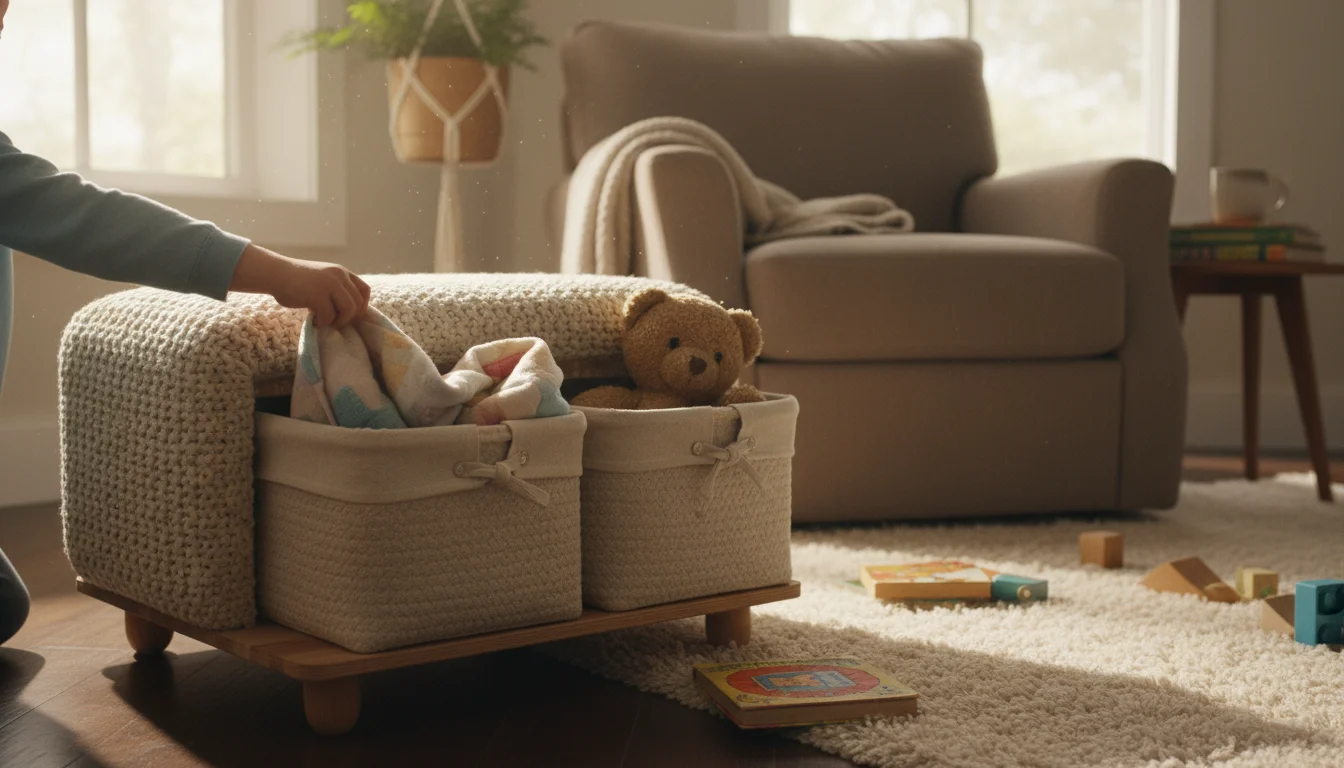
Living Room or Common Areas
Many families prefer their children to play in common areas. The key here is to have a discreet, easy-to-use system that allows for quick clean-up.
- Attractive Storage: Invest in furniture that blends with your decor but also offers storage. Think decorative baskets, storage ottomans, or credenzas with hidden compartments.
- Small, Portable Bins: Use small, lightweight bins that children can carry to their play area and then easily return to a designated storage spot (e.g., a cubby or cabinet) when play concludes.
- “Clean-Up Kits”: Keep a small bin with a few favorite toys in the living room, rather than the entire collection. This makes tidying up manageable at the end of the day.
- Vertical Shelving: If you have an unused corner, a slim bookcase can hold a few aesthetically pleasing toy bins or baskets.
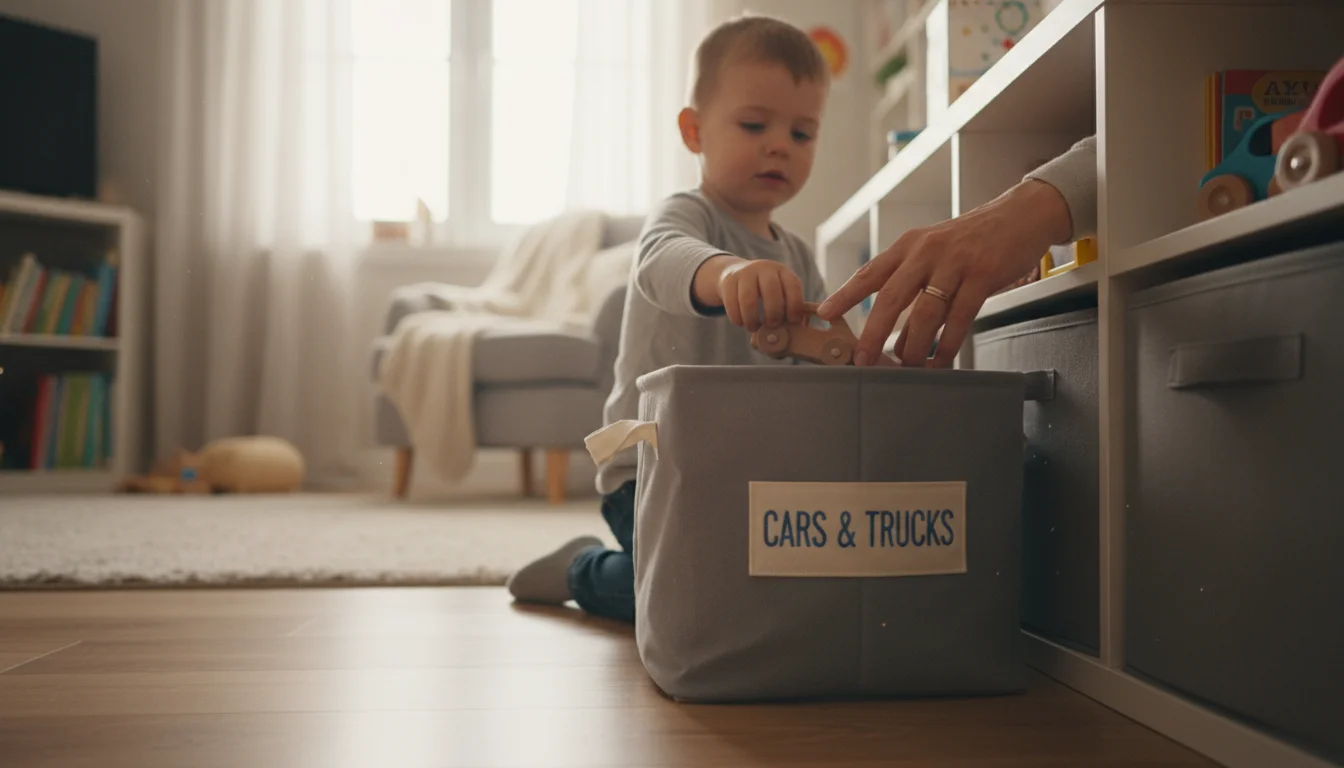
Maintaining Your Toy Organization System
Creating the system is only half the battle. Long-term success relies on consistent maintenance. You can avoid feeling overwhelmed by incorporating simple daily and weekly habits.
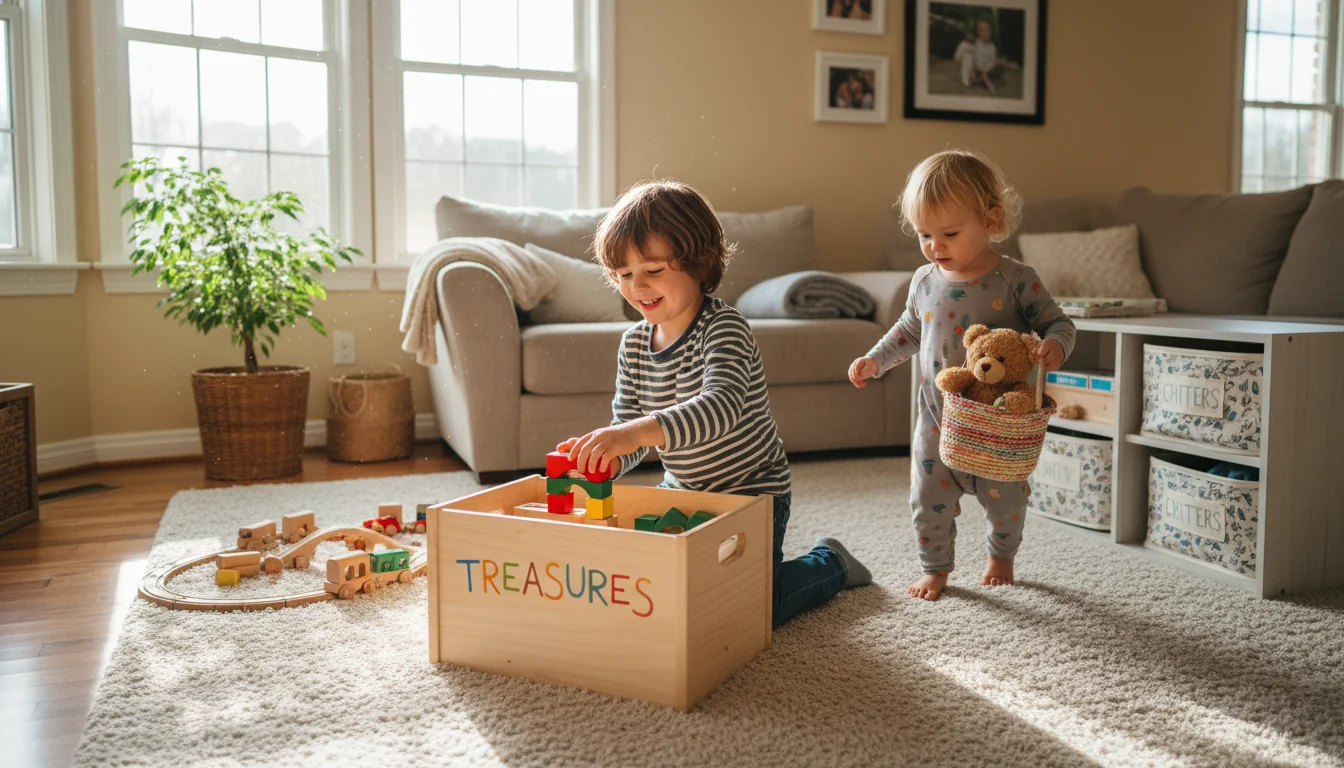
Daily Habits: The “Five-Minute Tidy”
Implement a quick clean-up routine. Before dinner, before bedtime, or before screen time, spend five to ten minutes with your children putting toys back in their designated spots. Make it a game, play music, or offer a small reward. Consistency is more important than perfection here.
- “Everything Has a Home” Rule: Reinforce the idea that every toy has a specific place. This prevents new clutter from accumulating.
- Basket Method: For younger children, provide a “collection basket” they can use to gather all loose items, then sort them into their proper homes.
- Role Modeling: Children learn by watching you. Demonstrate how you put away your own belongings.
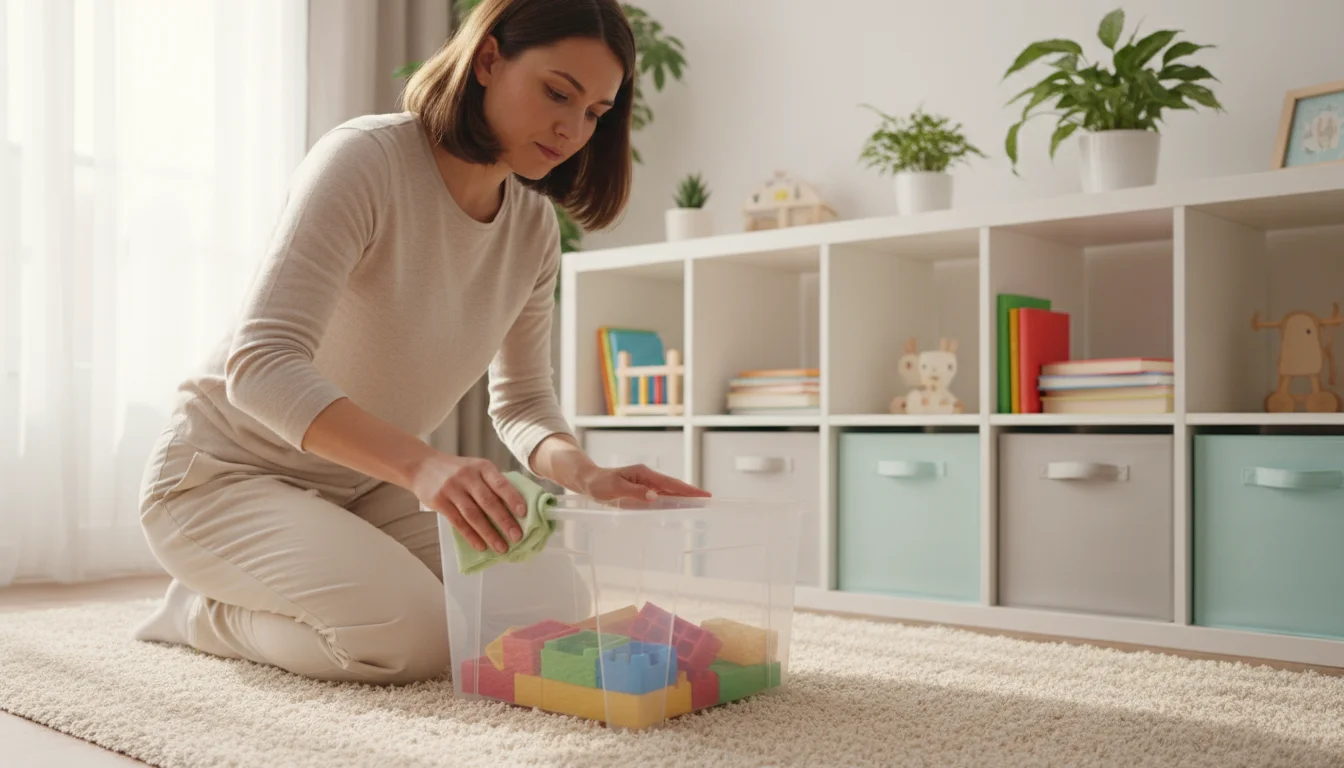
Weekly Reset: A Deeper Clean
Once a week, take about 30 minutes to do a more thorough reset. This might involve:
- Straightening shelves.
- Wiping down bins (especially for art supplies or food-related play items).
- Checking for missing pieces in puzzles and games.
- Adjusting labels if necessary.
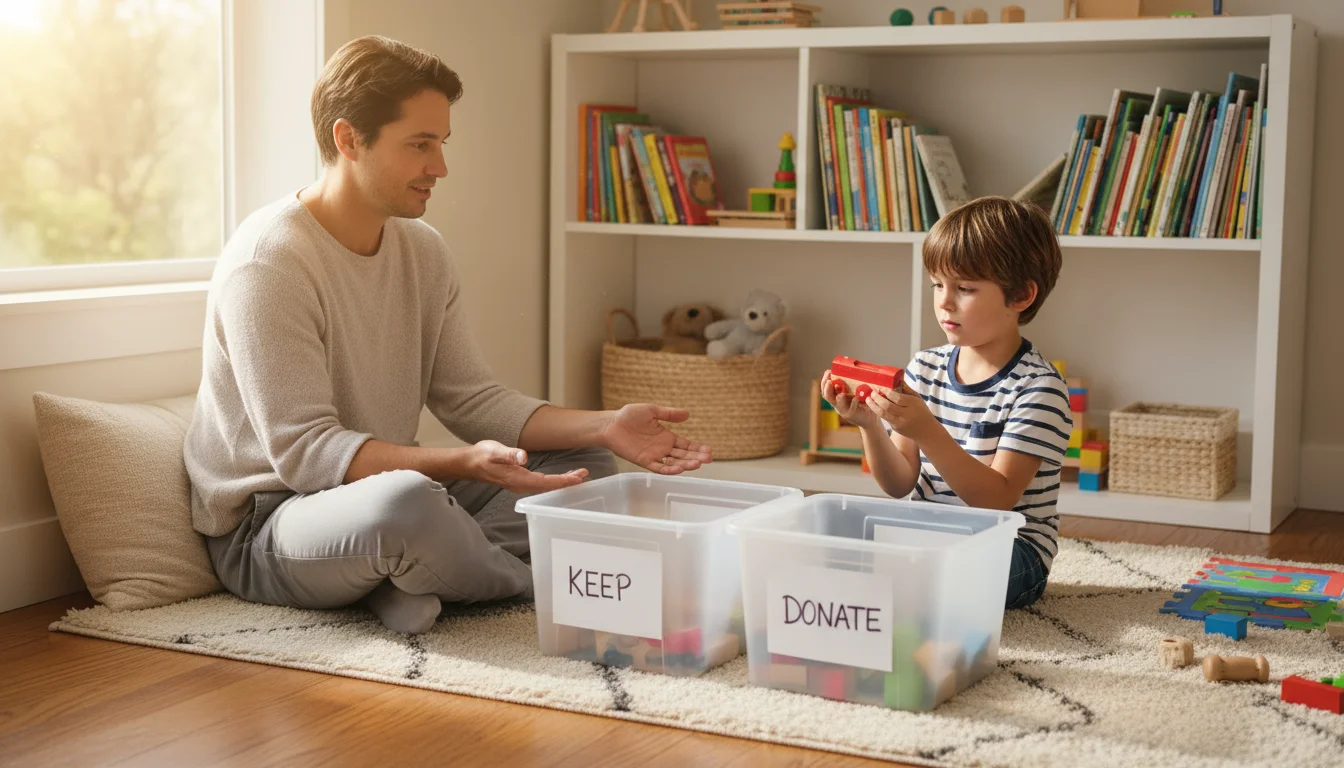
Seasonal Review: Adapting to Growth and Change
Children’s interests and developmental stages change rapidly. Every few months, or with each season change, perform a more comprehensive review of your toy collection. This aligns with our BrightLivingGuide.com ethos of realistic, evolving solutions.
- Declutter Again: Re-evaluate toys. Are they still played with? Are they age-appropriate? Has anything broken?
- Rotate Toys: Introduce toys from your “out of rotation” stash to keep things fresh and prevent boredom.
- Adjust Zones: As your child grows, their play patterns change. A toddler’s “active play” zone might become an older child’s “crafting” zone.
- Clean and Repair: Take this opportunity to clean toys that might have been overlooked, and make minor repairs if possible. Consult the CDC’s cleaning and disinfecting guidelines for toy hygiene.
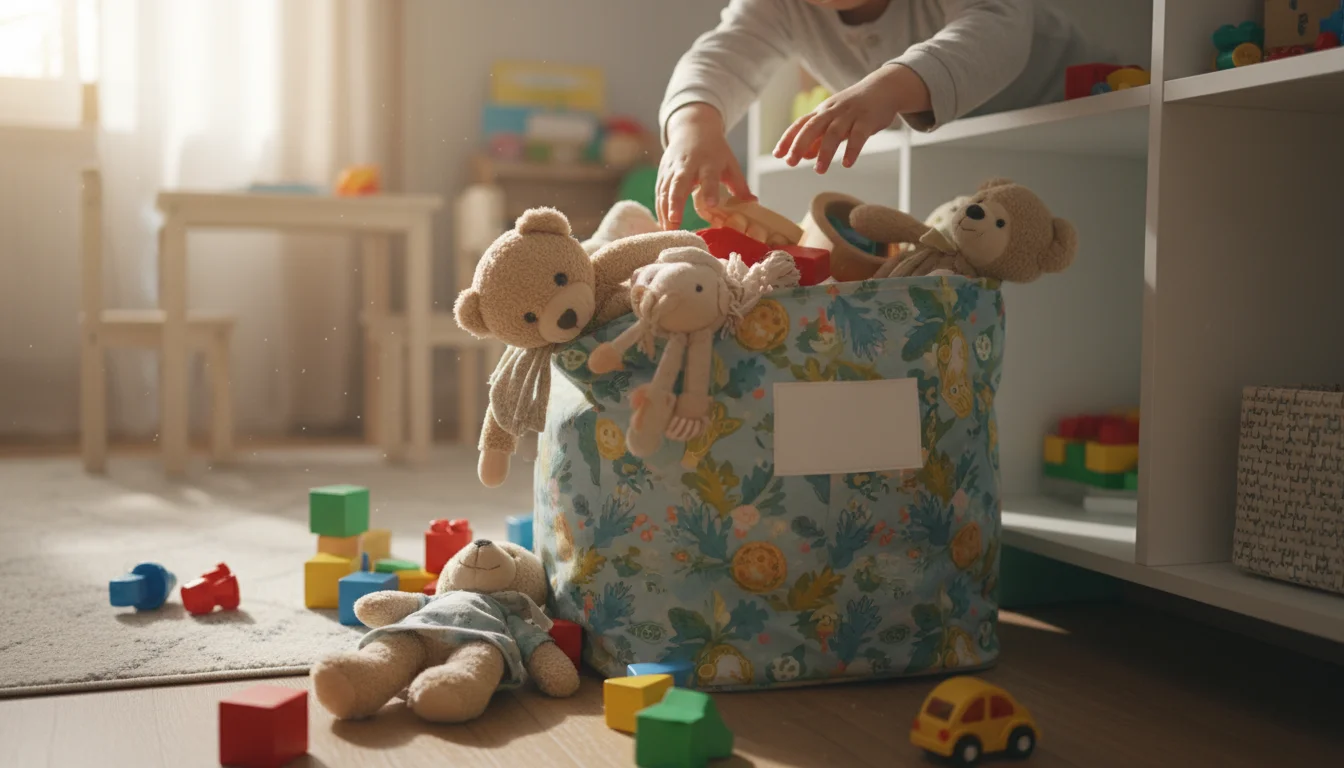
Troubleshooting Common Maintenance Mistakes
- Overstuffing: If bins are overflowing, it signals you still have too many toys or your storage solution is inadequate. Revisit the decluttering phase.
- Unclear Systems: If children (or even you) do not know where things go, the system will fail. Re-label, simplify categories, or adjust accessibility.
- Lack of Consistency: If clean-up routines are inconsistent, clutter quickly returns. Stick to a schedule.
- Ignoring Developmental Stages: A system designed for a 3-year-old will not work for a 7-year-old. Be prepared to adapt.
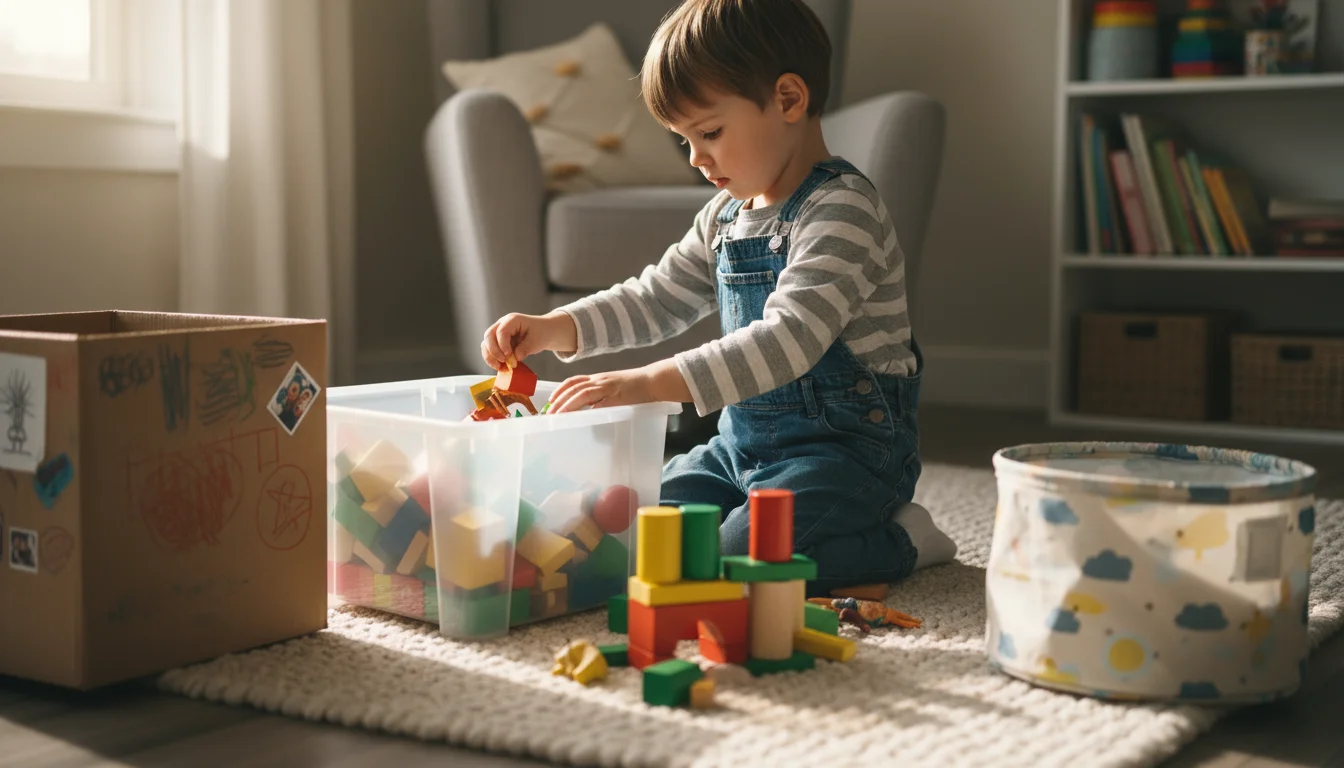
Budget-Friendly Toy Organization: Smart Choices for Every Home
Effective toy organization does not require a large budget. Many ingenious solutions use items you already own or inexpensive finds. Prioritize functionality and practicality over designer labels.
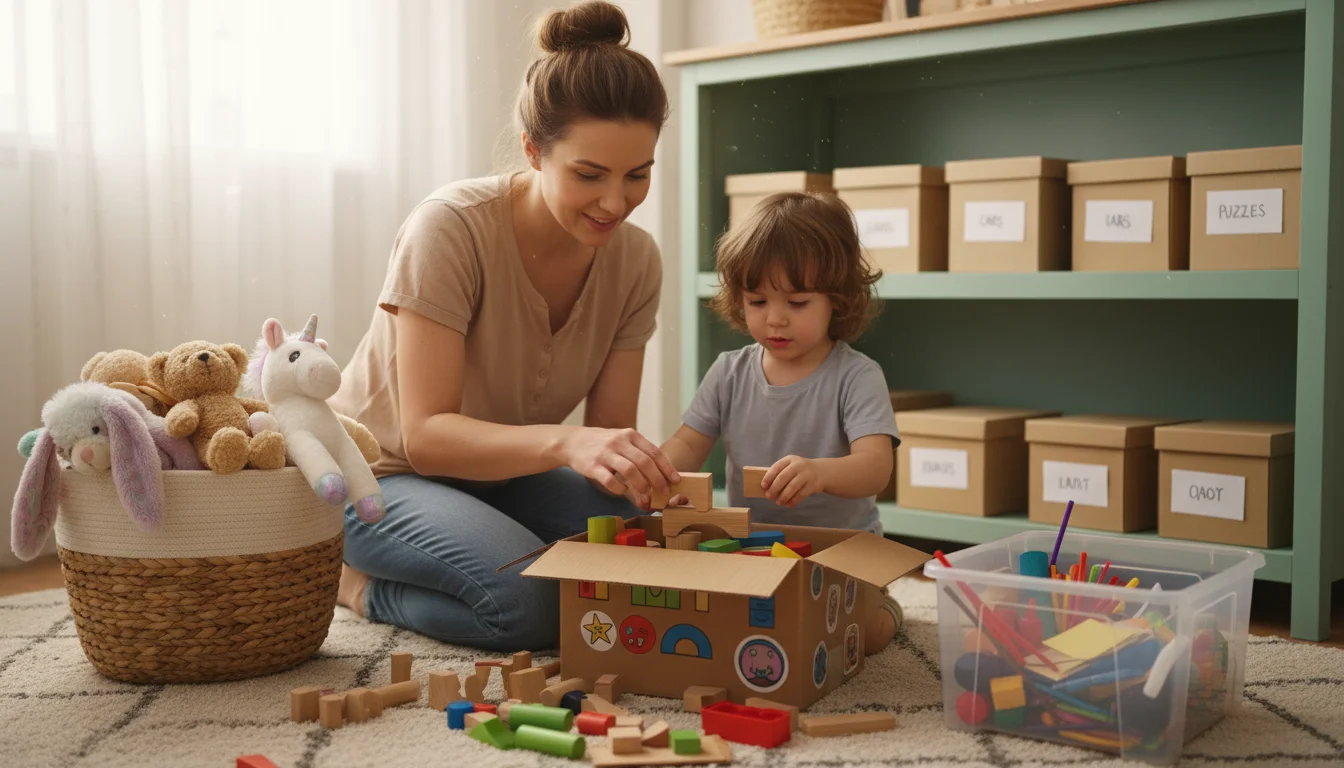
DIY Solutions and Repurposed Items
- Cardboard Boxes: Decorate sturdy cardboard boxes with paint or contact paper for custom, temporary storage.
- Laundry Baskets: Inexpensive plastic laundry baskets work wonderfully for larger, bulky toys like plush animals or blocks.
- Shoe Boxes: Ideal for sorting small items like game pieces, miniature figures, or art supplies within a larger drawer or bin.
- Old Dressers or Bookshelves: Give old furniture a new life with a fresh coat of paint. Remove drawers from a dresser to create open cubbies, or turn a horizontal bookshelf on its side for a low-level cubby unit.
- Clear Jars or Containers: Repurpose large food containers (e.g., pretzel containers, clear plastic tubs) for small items like craft pom-poms or beads.
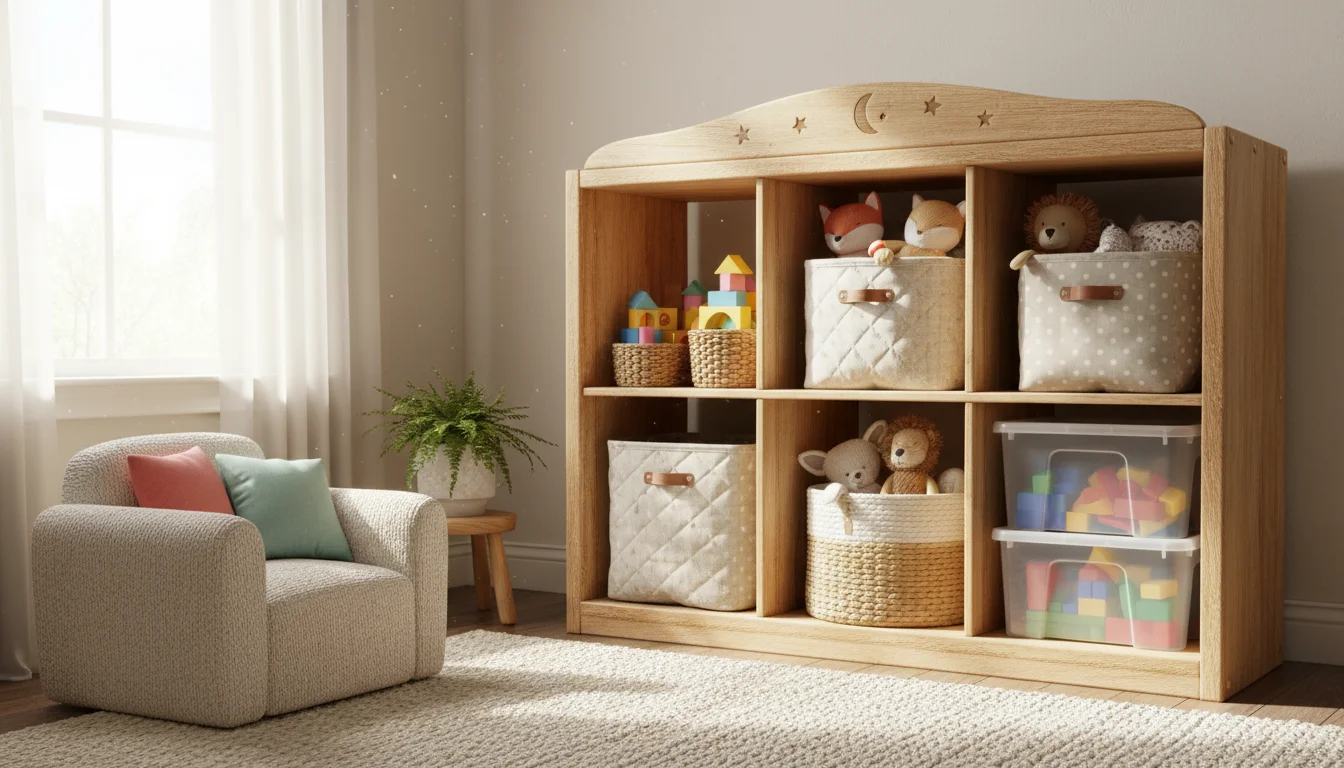
Thrift Store and Second-Hand Finds
Charity shops, garage sales, and online marketplaces (like Facebook Marketplace or Buy Nothing groups) offer fantastic opportunities for affordable storage.
- Baskets: Look for sturdy wicker, fabric, or plastic baskets.
- Shelving Units: You can often find well-built bookcases or cubby units at a fraction of their retail price. Inspect for stability and safety.
- Plastic Bins: Sometimes you can find good quality, lidded plastic bins.
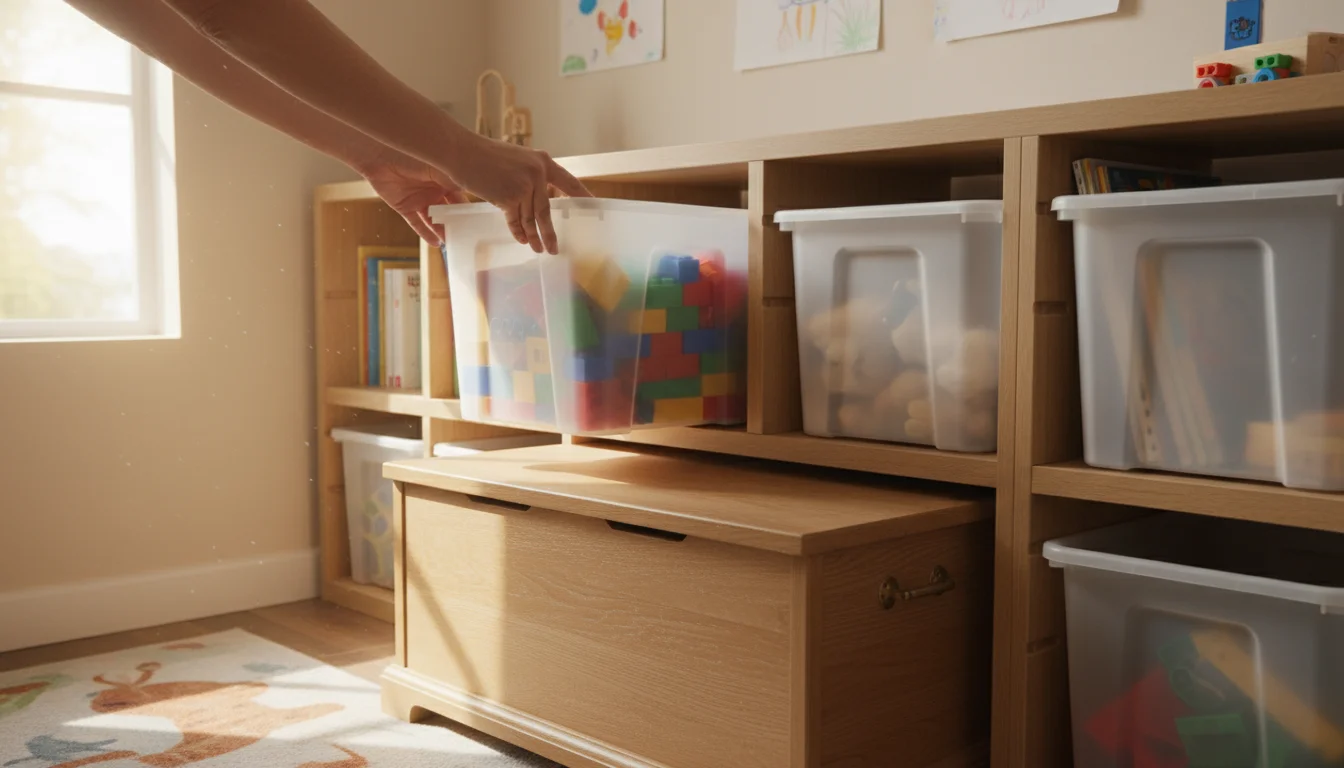
Smart Buys: Where to Invest
If you have some budget, invest in a few key pieces that offer long-term value and durability.
- Modular Cube Organizers: Units like the IKEA Kallax are a smart investment due to their versatility and longevity. You can add bins and inserts over time.
- Durable Clear Bins: High-quality, stackable clear bins withstand years of use and abuse. Brands like Sterilite or Rubbermaid often have sales.
- Safety-Tested Toy Chests: If you opt for a traditional toy chest, ensure it has a soft-close hinge mechanism to protect little fingers.
Remember, the best budget-friendly solution is one you can stick with. Start with what you have, and gradually upgrade or add pieces as your needs and budget allow. Focus on solutions that integrate seamlessly into your BrightLivingGuide.com realistic approach to home management.
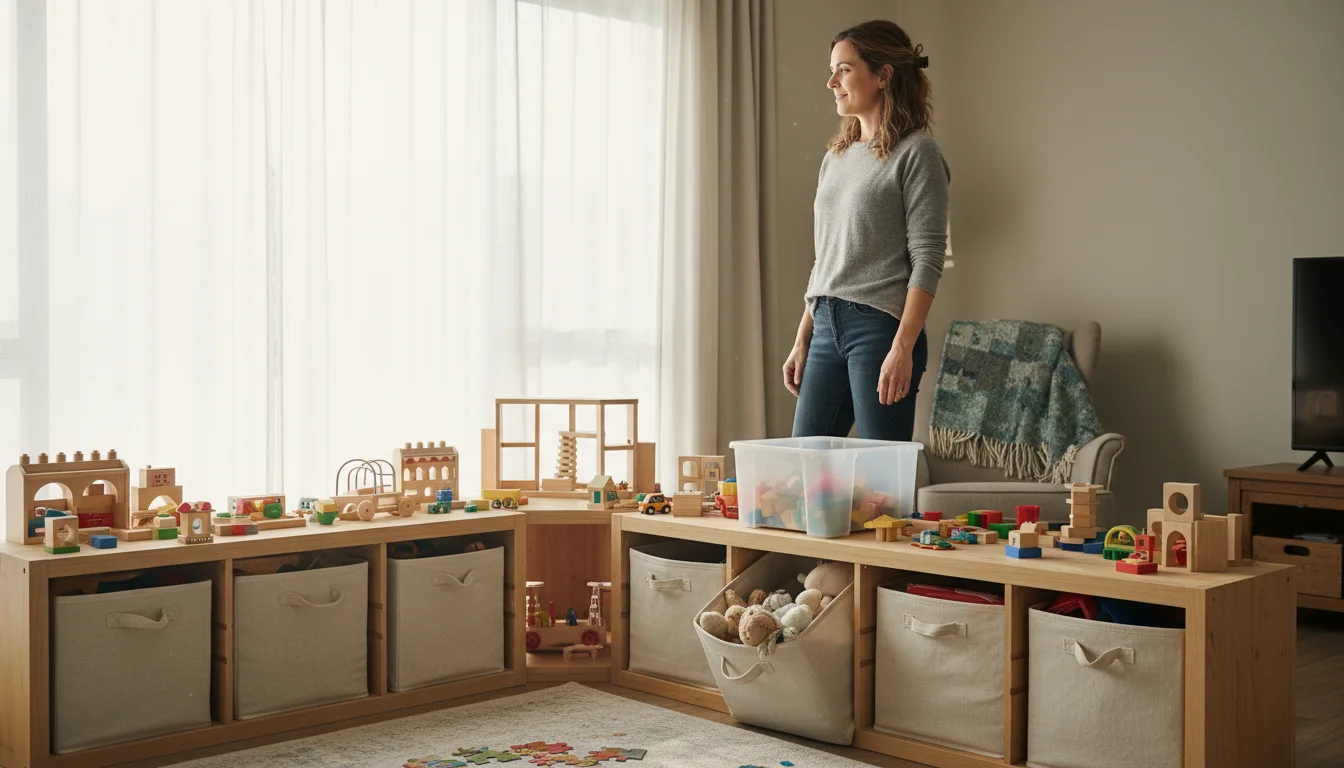
Frequently Asked Questions
How do I get my child to put away their toys?
Make clean-up a consistent routine and a positive experience. Use clear, simple instructions, sing a clean-up song, or make it a race. Start with small tasks they can accomplish, like putting one type of toy away, and gradually increase expectations. Positive reinforcement and making it fun work better than punishment.
What is the “toy rotation” method, and how do I implement it?
Toy rotation involves keeping only a portion of your child’s toys accessible at any given time, storing the rest out of sight. Every few weeks, swap out the visible toys with those in storage. This keeps toys feeling new, reduces clutter, and encourages deeper engagement with fewer items. Use opaque bins or closed cupboards for the “out of rotation” toys.
How do I organize LEGOs without losing all the tiny pieces?
LEGO organization requires specific strategies. Consider sorting by color, by brick type, or by set (if sets are kept together). Clear plastic containers with separate compartments, tackle boxes, or multi-drawer organizers work well for small pieces. Labeling is essential. You can also use large, flat plastic mats that toys can be built on and then gathered by pulling a drawstring.
My child’s room is tiny. What are the best toy storage solutions for small spaces?
For tiny rooms, prioritize vertical storage and multi-functional furniture. Think wall-mounted shelves, over-the-door organizers, under-bed storage bins, and cube organizers that can hold several bins. A toy rotation system also helps significantly by limiting the number of toys out at any given time, making the space feel less cluttered.
When should I declutter toys?
Establish a regular decluttering schedule. A major declutter can happen once or twice a year, perhaps before birthdays and holidays, or at the start of a new school year. Implement mini-declutters monthly or quarterly, focusing on specific categories. Involve your child in age-appropriate ways to empower them in the process.
For expert home organization guidance, visit
HGTV — Home, Apartment Therapy, The Container Store — Organization Tips, IKEA Home Organization and Martha Stewart — Home.
Disclaimer: This article is for informational purposes only and is not a substitute for professional advice. Consult professional organizers or specialists for personalized recommendations.
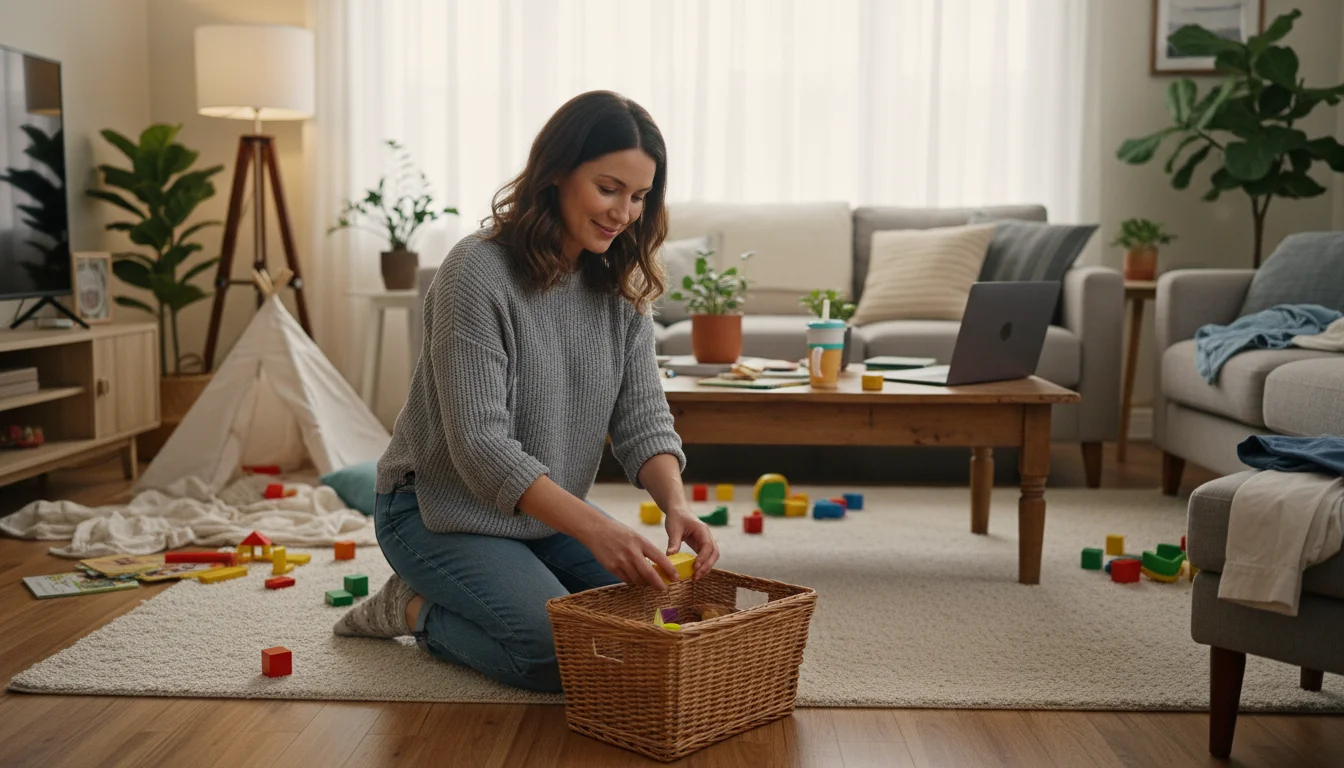
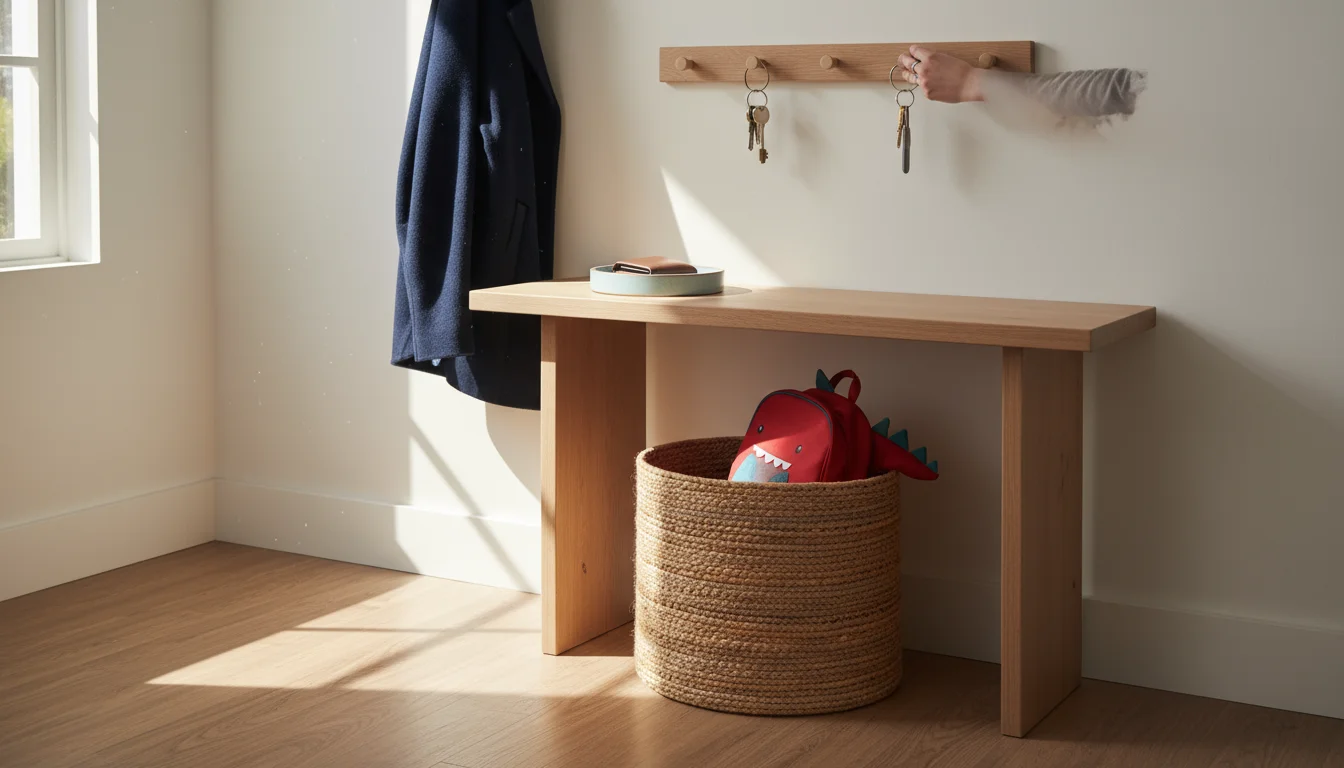
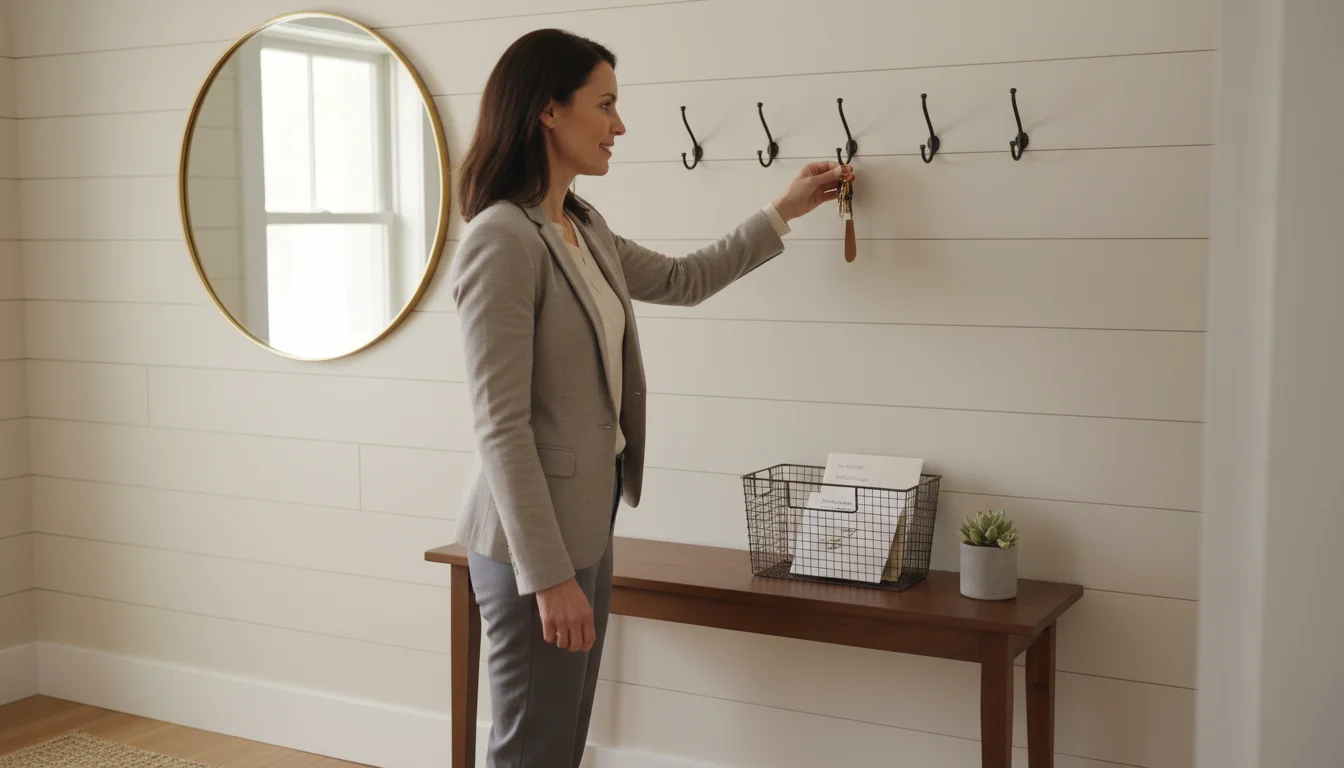
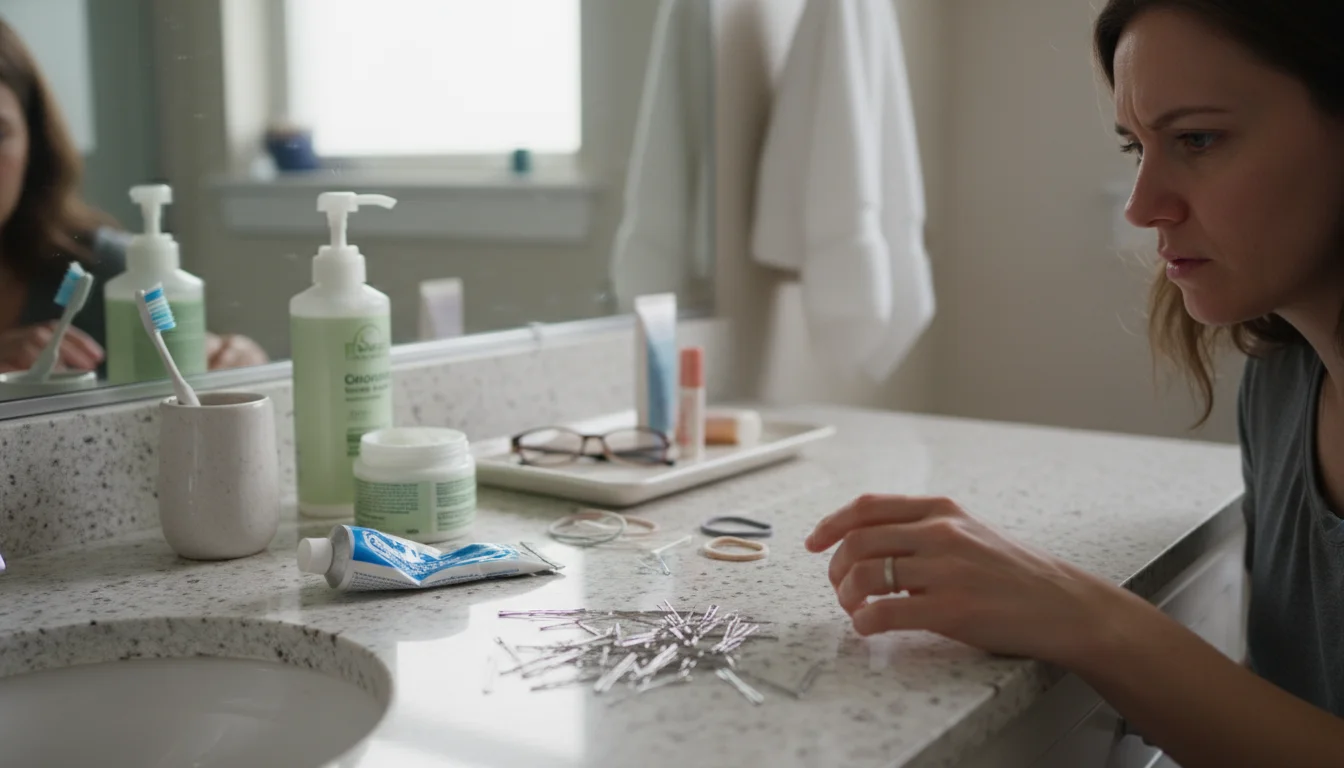
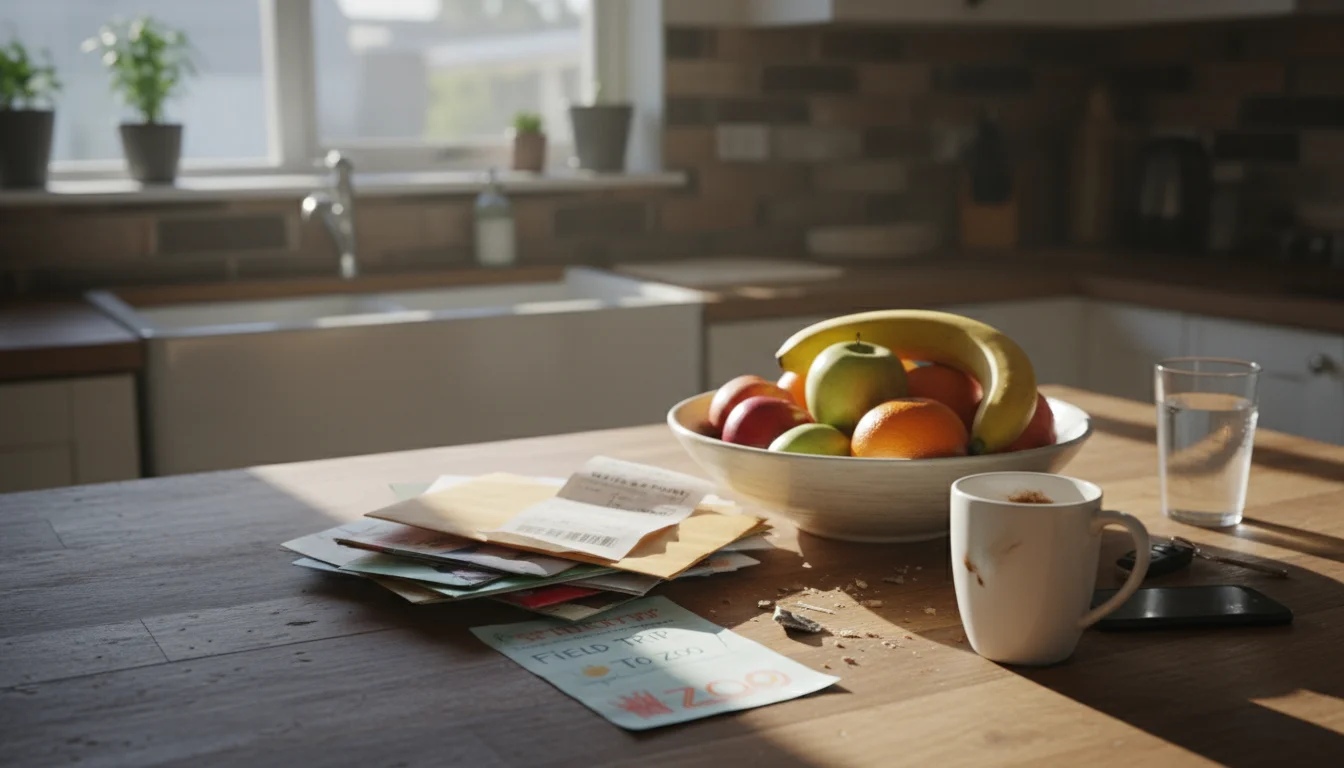

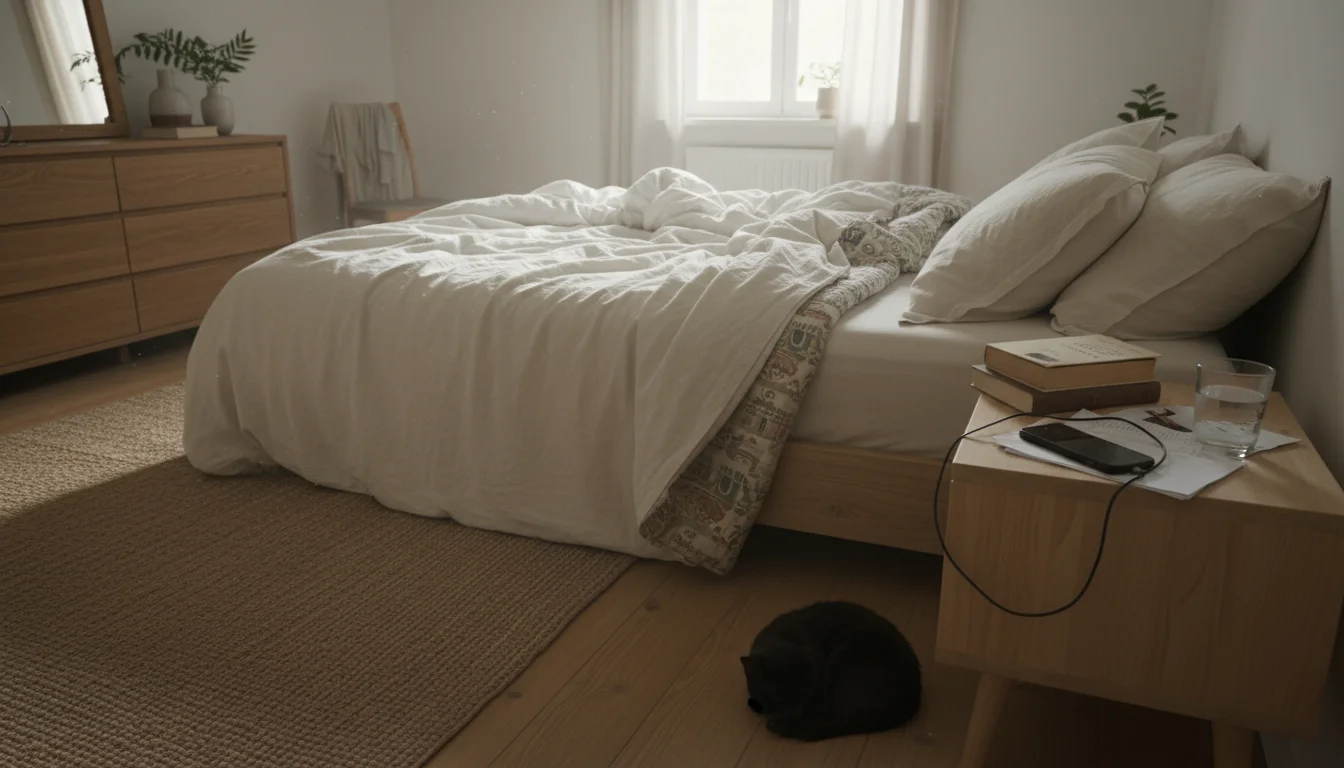

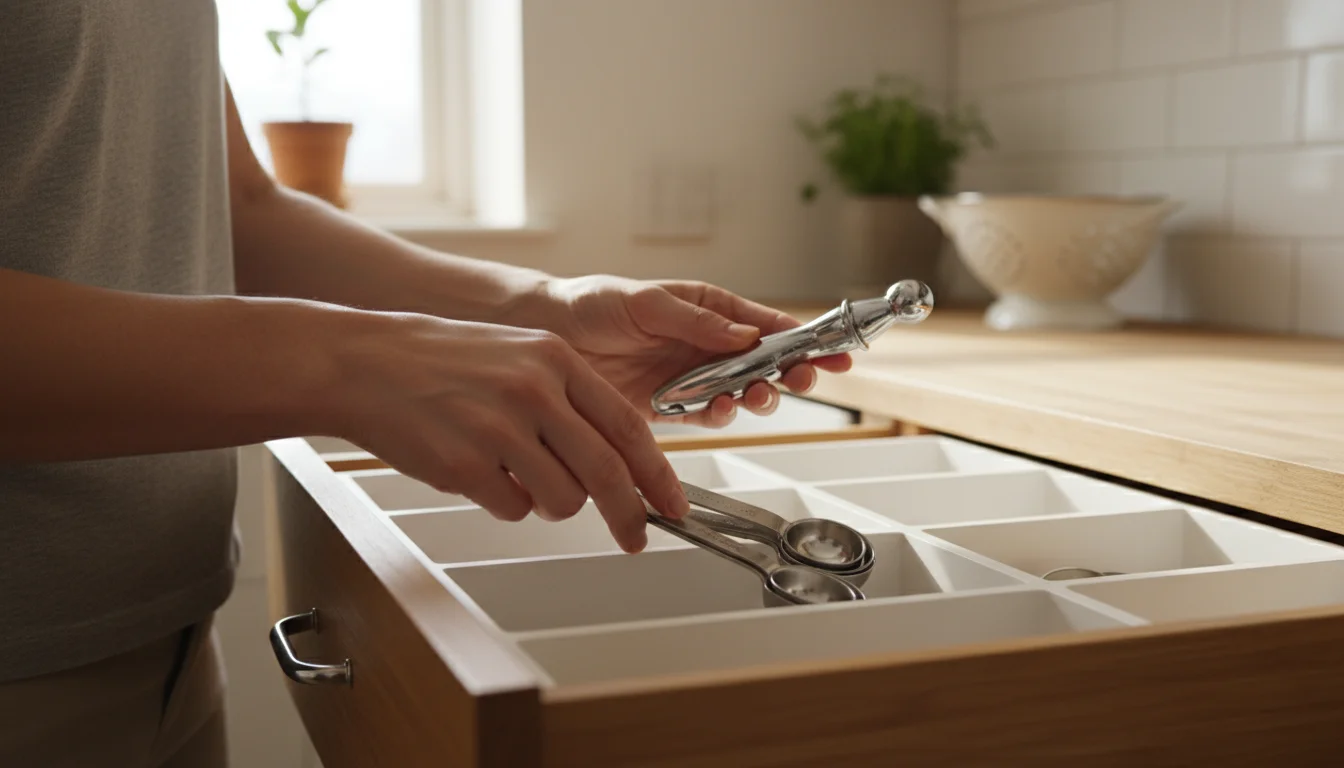
Leave a Reply